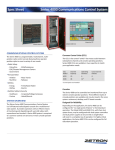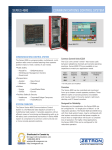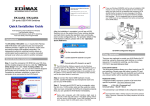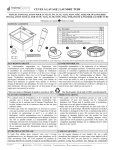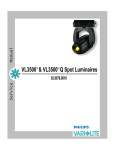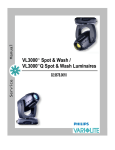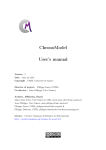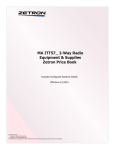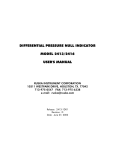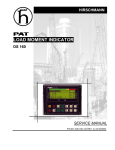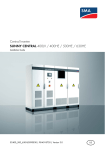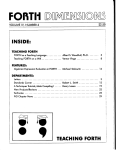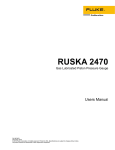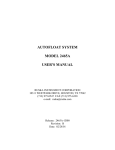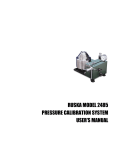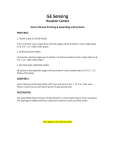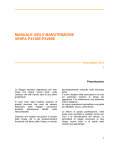Download MODEL 2465A-754 USER`S MANUAL
Transcript
GAS LUBRICATED PISTON PRESSURE GAGE MODEL 2465A-754 USER’S MANUAL RUSKA INSTRUMENT CORPORATION 10311 WESTPARK DR., HOUSTON, TEXAS 77042 (713) 975-0547 FAX: (713) 975-6338 E-MAIL: [email protected] http://www.ruska.com Release: 2465A-2D00 Revision B Date: November 4, 2002 -i- INTRODUCTION WARRANTY Ruska Instrument Corporation warrants its products to conform to or exceed the specifications as set forth in its catalogs in use at the time of sale and reserves the right, at its own discretion, without notice and without making similar changes in articles previously manufactured, to make changes in materials, designs, finish, or specifications. Ruska Instrument Corporation warrants products of its own factory against defects of material or workmanship for a period of one year from date of shipment. Liability of Ruska Instrument Corporation under this warranty shall be limited to replacing, free of charge (FOB Houston, Texas), any such parts proving defective within the period of this warranty, but will not be responsible for transportation charges or consequential damages. This warranty is not made for products manufactured by others which are illustrated and described in Ruska catalogs or incorporated in Ruska products in essentially the same form as supplied by the original manufacturer. However, Ruska Instrument Corporation agrees to use its best efforts to have original suppliers make good their warranties. -ii- INTRODUCTION COPYRIGHT NOTICE Copyright ¤ 1990, 1991, 1992 by Ruska Instrument Corporation. All rights reserved. This document may not be reproduced in part or in whole without the express written consent of Ruska Instrument Corporation. DISCLAIMER No representations or warranties are made with respect to the contents of this user's manual. Further, Ruska Instrument Corporation reserves the right to revise this manual and to make changes from time to time in the content hereof without obligation to notify any person of such revision. TRADEMARK NOTICE £ is a trademark of Ruska Instrument Corporation. Trademarks or tradenames are subject to state and federal laws concerning their unauthorized use or other infringements. The fact that the product marks or names in this manual do not bear a trademark symbol DOES NOT mean that the product name or mark is not registered as a trademark or tradename. Any queries concerning the ownership or existence of any trademarks or tradenames mentioned in this manual should be independently confirmed with the manufacturer or distributor of the product. -iii- INTRODUCTION REVISION NOTICE RELEASE NUMBER REVISION DATE OF REVISION DESCRIPTION 2465A-2D00 A 01/30/99 Original release. 2465A-2D00 B 11/04/02 Made numerous DC/RO 23708 -iv- changes, see INTRODUCTION REVISION HISTORY 2465A-2D00 (January 30, 1999) Original release 2465A-2D00 (November 4, 2002) Numerous changes see DC/RO 23708 -v- INTRODUCTION WARNING PRESSURIZED VESSELS AND ASSOCIATED EQUIPMENT ARE POTENTIALLY DANGEROUS. THE APPARATUS DESCRIBED IN THIS MANUAL SHOULD BE OPERATED ONLY BY PERSONNEL TRAINED IN PROCEDURES THAT WILL ASSURE SAFETY TO THEMSELVES, TO OTHERS, AND TO THE EQUIPMENT. DO NOT USE OXYGEN AS THE PRESSURE SUPPLY MEDIA. USE ONLY DRY, CLEAN NITROGEN. DO NOT EXCEED SAFE MAXIMUM INLET PRESSURES AS FOLLOWS: WITH LOW RANGE PISTON/CYLINDER: 40 PSIA (POUNDS PER SQUARE INCH ABSOLUTE) WITH MID RANGE PISTON/CYLINDER: 115 PSIA WITH MID/HIGH RANGE PISTON/CYLINDER: 515 PSIA WITH HIGH RANGE PISTON/CYLINDER: 1015 PSIA DO NOT USE HYDROCARBON LUBRICANTS. USE ONLY RUSKA INSTRUMENT CORPORATION SUPPLIED LUBRICANT, PART NUMBER 45-339, UNLESS OTHERWISE SPECIFIED IN THIS MANUAL. ALWAYS USE REPLACEMENT PARTS SPECIFIED BY RUSKA INSTRUMENT CORPORATION. WHEN ANY MAINTENANCE IS PERFORMED, TURN OFF POWER AND REMOVE POWER CORD. -vi- INTRODUCTION OXYGEN COMPATIBILITY This instrument has been designed with components that will not introduce hydrocarbons into the calibration process. The O-ring and lubricating grease supplied with the instrument must not be substituted with other laboratory supplies. Cleaning of the instrument for oxygen compatibility using liquid Freon and ultrasonic cleaning systems is permitted with the EXCEPTION OF THE PISTONS AND CYLINDERS. The Ruska procedures for piston/cylinder cleaning as described in Section 6.0 of this manual must be followed. ULTRASONIC CLEANING MAY DAMAGE THE CRYSTALLINE STRUCTURE OF THE TUNGSTEN CARBIDE PISTONS AND CYLINDERS. -vii- INTRODUCTION TABLE OF CONTENTS WARRANTY ........................................................................................................... -iiCOPYRIGHT NOTICE, DISCLAIMER, TRADEMARK NOTICE .................................... -iiiREVISION NOTICE ............................................................................................... -ivREVISION HISTORY............................................................................................... -vWARNING ........................................................................................................... -viOXYGEN COMPATIBILITY.....................................................................................-viiTABLE OF CONTENTS .........................................................................................-viiiLIST OF FIGURES AND TABLES .............................................................................. -xSECTION 1.0 SPECIFICATIONS 1.1 SPECIFICATIONS ................................................................................1-1 SECTION 2.0: GENERAL PISTON PRESSURE GAGE CONSIDERATIONS 2.1 TYPES OF PISTON PRESSURE GAGES...................................................2-1 2.2 MEASUREMENT OF PRESSURE WITH THE PISTON PRESSURE GAGE ......2-3 2.3 ELASTIC DISTORTION OF THE CYLINDER............................................2-3 2.4 GRAVITY.............................................................................................2-3 2.5 BUOYANT EFFECT OF THE AIR............................................................2-3 2.6 TEMPERATURE ....................................................................................2-4 2.7 REFERENCE PLANE OF MEASUREMENT ...............................................2-4 2.8 CROSSFLOATING...............................................................................2-5 2.9 BIBLIOGRAPHY ...................................................................................2-7 SECTION 3.0: DESCRIPTION 3.1 GENERAL INFORMATION ...................................................................3-1 3.2 DESCRIPTION OF THE MASS SET.........................................................3-1 SECTION 4.0: INSTALLATION 4.1 INSTALLATION ...................................................................................4-1 SECTION 5.0: OPERATION 5.1 PRECAUTIONS....................................................................................5-1 5.2 GENERAL ...........................................................................................5-1 5.3 LOW RANGE PISTON ASSEMBLY .........................................................5-2 5.4 MID RANGE PISTON ASSEMBLY ..........................................................5-2 5.5 35 BAR ASSEMBLY ..............................................................................5-2 5.6 HIGH RANGE PISTON ASSEMBLY ........................................................5-3 5.7 ESTABLISHING PRESSURE ....................................................................5-3 5.7.1 Gage Pressures .........................................................................5-3 5.8 MAINTENANCE OF THE GAGE ..........................................................5-4 SECTION 6.0: PISTON/CYLINDER CLEANING INSTRUCTIONS 6.1 GENERAL INFORMATION AND PREPARATION .....................................6-1 6.2 FUNCTIONAL TESTING OF PISTON/CYLINDER ASSEMBLIES ................6-2 6.3 CLEANING THE LOW RANGE PISTON/CYLINDER ASSEMBLY ...............6-2 6.4 MID RANGE PISTON/CYLINDER ..........................................................6-3 -viii- INTRODUCTION 6.5 6.6 CLEANING THE 35 BAR PISTON/CYLINDER ASSEMBLY ........................6-4 CLEANING THE HIGH RANGE PISTON/CYLINDER ASSEMBLY ..............6-5 APPENDIX A: CALCULATIONS A.1 EXPLANATION OF "PRESSURE CALCULATION WORKSHEET" (TABLES A-9 AND A-11) ......................................................................A-1 APPENDIX B: DRAWINGS AND BILLS OF MATERIAL ........................................... B-1 DRAWINGS BILLS OF MATERIAL -ix- INTRODUCTION LIST OF FIGURES AND TABLES FIGURE 2-1: FIGURE 2-2: FIGURE 2-3: SIMPLE CYLINDER ...............................................................................2-1 RE-ENTRANT CYLINDER ......................................................................2-1 CONTROLLED CLEARANCE CYLINDER ................................................2-1 FIGURE 3-1: FIGURE 3-2: GAS LUBRICATED PISTON PRESSURE GAGE ........................................3-3 GAS LUBRICATED PISTON PRESSURE GAGE ........................................3-5 FIGURE 5-1A: FIGURE 5-1: FIGURE 5-2: FIGURE 5-3: FIGURE 5-4: FIGURE 5-5: FIGURE 5-6: STACK-UP FOR PISTON OPERATION...................................................5-6 PARTS REQUIRED FOR LOW RANGE PISTON OPERATION ...................5-7 REMOVING LOW RANGE PISTON AND CYLINDER FROM CONTAINER 5-9 REMOVING LOW RANGE PISTON AND CYLINDER FROM CONTAINER 5-9 HANDLING LOW RANGE PISTON AND CYLINDER .............................5-11 LOW RANGE PISTON AND CYLINDER SHOWING O-RING GROOVE .5-11 POSITIONING THE UPPER THRUST WASHER/PISTON RETAINER IN THE CYLINDER RETAINING CAP RECESS........................................5-13 FIGURE 5-7: PARTS REQUIRED FOR OPERATION OF THE MID RANGE P/C ............5-15 FIGURE 5-8: MID RANGE PISTON/CYLINDER ASSEMBLY........................................5-17 FIGURE 5-9: RETAINING NUT AND BEARING ........................................................5-17 FIGURE 5-10: PARTS REQUIRED FOR HIGH RANGE PISTON OPERATION ................5-19 FIGURE 5-11: PARTS REQUIRED FOR OPERATION OF THE 35 BAR P/C....................5-21 FIGURE 6-1: FIGURE 6-2: FIGURE 6-3: FIGURE 6-4: FIGURE 6-5: FIGURE 6-6: FIGURE 6-7: FIGURE 6-8: FIGURE 6-9: FIGURE 6-10: FIGURE 6-11: FIGURE 6-12: FIGURE 6-13: FIGURE 6-14: MATERIALS FOR CLEANING LOW RANGE PISTON/CYLINDER ..............6-7 PREPARATIONS FOR CLEANING THE LOW RANGE CYLINDER ..............6-7 PREPARING THE KIM-WIPES ................................................................6-9 PREPARING THE KIM-WIPES ................................................................6-9 PREPARING THE LOW RANGE CLEANING TOOL ...............................6-11 PREPARING THE LOW RANGE CLEANING TOOL ...............................6-11 MATERIALS FOR CLEANING MID RANGE PISTON/CYLINDER..............6-13 PREPARING THE MID RANGE CLEANING TOOL.................................6-13 MATERIALS FOR CLEANING HIGH RANGE PISTON/CYLINDER............6-15 PREPARING KIM-WIPES FOR CLEANING HIGH RANGE CYLINDER.......6-15 PREPARING KIM-WIPES FOR CLEANING HIGH RANGE CYLINDER.......6-17 PREPARING KIM-WIPES FOR CLEANING HIGH RANGE CYLINDER.......6-17 CLEANING THE HIGH RANGE CYLINDER ..........................................6-19 DRYING THE HIGH RANGE CYLINDER...............................................6-19 TABLE A-1: TABLE A-2: TABLE A-3: TABLE A-4: CONVERSION FACTORS ................................................................... A-7 STANDARD PRESSURES FOR PISTON PRESSURE GAGE (ENGLISH)........ A-2 STANDARD PRESSURES FOR PISTON PRESSURE GAGE (SI)................... A-2 AIR DENSITY ...................................................................................... A-6 -x- INTRODUCTION SECTION 1.0 SPECIFICATION 1.1 SPECIFICATIONS LOW RANGE PISTON: Pressure Range (Model 2465): Pressure Range (Model 2468): Pressure Uncertainty Rating: Uncertainty Threshold: Resolution: Precision (Typical Type A Unc.): Long Term Stability: Piston/Cylinder Material: Thermal Coefficient: Sink Rate at Maximum Pressure: 1.4 to 172 kPa (0.2 to 25 psi) absolute, gauge or negative gauge (1) 1.4 to 345 kPa (0.2 to 50 psi) absolute, gauge or negative gauge (1) 0.0010% (10 ppm) or 0.07 Pa (1.0E-05 psi), whichever is greater (2,3) 7 kPa (1 psi) 1 ppm or 1 mg, whichever is greater 2 ppm (3) 1 ppm per year 440C Stainless Steel/Tungsten Carbide 1.5E-05 per deg. C typical <2 mm per minute, maximum 4 mm per minute MID RANGE PISTON: Pressure Range (Model 2465): Pressure Range (Model 2468): Pressure Uncertainty Rating: Uncertainty Threshold: Resolution: Precision (Typical Type A Unc.): Long Term Stability: Piston/Cylinder Material: Thermal Coefficient: Sink Rate at Maximum Pressure: 12 to 700 kPa (1.7 to 100 psi) absolute or gauge 12 to 1380 kPa (1.7 to 200 psi) absolute or gauge 0.0010% (10 ppm) or 0.28 Pa (4.0E-05 psi), whichever is greater (2,3) 27.6 kPa (4 psi) 1 ppm or 1 mg, whichever is greater 2 ppm (3) 1 ppm per year Tungsten Carbide/Tungsten Carbide 9.1E-06 per deg. C typical <2 mm per minute, maximum 4 mm per minute 35 BAR PISTON: Pressure Range (Model 2465): Pressure Range (Model 2468): Pressure Uncertainty Rating: Uncertainty Threshold: Resolution: Precision (Typical Type A Unc.): Long Term Stability: Piston/Cylinder Material: Thermal Coefficient: Sink Rate at maximum Pressure: 14 to 3500 kPa (2 to 500 psi) absolute or gauge 14 to 7000 kPa (2 to 1000 psi) absolute or gauge 0.0011% (11 ppm) or 2.8 Pa (4.0E-04 psi), whichever is greater (2,3) 248 kPa (36 psi) 1 ppm or 1 mg, whichever is greater 2 ppm (3) 1 ppm per year Tungsten Carbide/Tungsten Carbide 9.1E-06 per deg. C Typical <2 mm per minute, maximum 4 mm per minute HIGH RANGE PISTON: Pressure Range: Pressure Uncertainty Rating: Uncertainty Threshold: Resolution: Precision (Typical Type A Unc.): Long Term Stability: Piston/Cylinder Material: Thermal Coefficient: Sink Rate at Maximum Pressure: (1) (2) (3) 14 to 7000 kPa (2 to 1000) absolute or gauge 0.0011% (11 ppm) or 2.8 Pa (4.0E-04 psi), whichever is greater (2,3) 248 kPa (36 psi) 1 ppm or 1 mg, whichever is greater 2 ppm (3) 1 ppm per year Tungsten Carbide/Tungsten Carbide 9.1E-06 per deg. C typical <2 mm per minute, maximum 4 mm per minute Negative gauge pressure limited by local barometric pressure. Absolute mode uncertainty higher due to reference pressure sensor. Approximate 95% level of confidence (Refer to Section 1.2 and Calibration Report.) 1-1 SPECIFICATION MASS SET: Approximate Total Mass Model 2465: 6.31 kg Approximate Total Mass Model 2468: 12.31 kg Approximate Carrier Mass: 0.1 kg Smallest Increment: 10 gram Mass Material: 300 Series, Non-magnetic, Austenitic, Stainless Steel (4) Adjustment Method: Completely machined with no fill cavities Mass Uncertainty: 0.0005% (5 ppm) or 5E-07 kg, whichever is greater Optional Fine Increment Trim Set: ASTM Class 1, 20g to 1 mg (4) Low mass carrier and plate may be of other non-magnetic material. TEMPERATURE RANGE: OPERATING: STORAGE: HUMIDITY RANGE: OPERATING: STORAGE: 18 to 28 degrees C -40 to 70 degrees C when thermometer and low range piston & Cylinder are stored separately from each other. 20 to 75% non-condensing 0 to 90% non-condensing PRESSURE MEDIUM: Clean dry gas, Nitrogen or equivalent, regulated to a Pressure Compatible with each particular piston/cylinder assembly. Dew Point of less than or equal to -60 degrees F. PRESSURE: MAXIMUM WORKING PRESSURE: With High Range Piston/Cylinder 1000 PSIG With Mid Range Piston/Cylinder 100 PSIG With Low Range Piston/Cylinder 25 PSIG NOTE: The pressurized housing has been tested to 2000 PSIG. POWER REQUIREMENTS: 15 watts, 115 VAC or 230 VAC; 50 or 60 Hz SPECIFICATION 1-2 SECTION 2.0 GENERAL PISTON PRESSURE GAGE CONSIDERATIONS 2.1 TYPES OF PISTON PRESSURE GAGES The piston pressure gage is sometimes regarded as an absolute instrument because of the principle by which it measures pressure. An absolute instrument is defined here as one capable of measuring a quantity in the fundamental units of mass, length, time, etc. It may be suggested that only certain types of piston pressure gages qualify in this category. Figures 2-1, 2-2, and 2-3 illustrate the three most common types of cylinder arrangements. When the simple cylinder of Figure 2-1 is subjected to an increase in pressure, the fluid, exerting a relatively large total force normal to the surface of confinement, expands the cylinder and thus increases its area. A pressure-drop appears across the cylinder wall near point A, resulting in an elastic dilation of the cylinder bore. It can be shown that the effective area of the piston and cylinder assembly is the mean of the individual areas of the piston and of the cylinder; therefore as the pressure is increased, the cylinder expands and the effective area becomes greater. The rate of increase is usually, but not always, a linear function of the applied pressure. The piston also suffers distortion from the end-loading effects and from the pressure of the fluid, but to a much lesser extent than the cylinder. It is evident, then, that the simple cylinder of Figure 2-1 would be inadequate for a primary piston pressure gage unless some means of predicting the change in area were available. The increase in the effective area of the simple cylinder is also accompanied by an increase in the leakage of the fluid past the piston. Indeed, the leakage becomes so great at some pressures that insufficient floating time can be maintained for a proper pressure measurement. In Figure 2-2, the pressure fluid is allowed to surround the body of the cylinder. The pressure drop occurs across the cylinder wall near the top of the cylinder at point B, but in the opposite direction to that of the simple cylinder in Figure 2-1. In consequence, the elastic distortion is directed toward the piston, tending to decease the area of the cylinder. 2-1 CONSIDERATIONS Again, the change in area with changing pressure places a limit on the usefulness of the cylinder in Figure 2-2 as a primary instrument. But some benefit results from the use of this cylinder in the construction of a piston pressure gage because higher pressures may be attained without a loss in float time. A small sacrifice is made in the float time at lower pressures because the total clearance between piston and cylinder must necessarily be greater at low pressure for the cylinder in Figure 2-2 than for the cylinder in Figure 21. In the controlled-clearance design of Figure 2-3, the cylinder is surrounded by a jacket to which a secondary fluid pressure system is connected. Adjustment of the secondary, or jacket, pressure permits the operator to change the clearance between the cylinder and piston at will. A series of observations involving piston sink rates at various jacket pressures leads to the empirical determination of the effective area of the assembly. In the United States, the controlled-clearance piston pressure gage is the accepted standard of pressure at levels higher than those that are practical for the mercury manometer. Piston pressure gages having very high resolutions may be made by using simple and reentrant cylinders. A determination of the distortion coefficients of such gages may be made by direct comparison with a controlled-clearance gage. Most piston pressure gages have some elastic distortion, but some, used in the very low pressures, have only small coefficients and, in some instances, correction for distortion may be neglected. Measurement of pressure with the piston pressure gage is subject to uncertainties resulting from effects other than those of elastic distortion. But, it was appropriate that the subject of elastic distortion be discussed first, since this characteristic is largely responsible for the various designs that have been developed. Measurement processes proposed for high accuracy are disturbed by limitations in the performance of the equipment, by small changes in the environment and by operational procedures. The disturbances can be reduced to a degree by exercising control of the apparatus. Some of the disturbances are difficult to control; it is easier to observe their magnitudes and apply corrections for their effects. The factors that affect a pressure measurement process when conducted with a piston pressure gage are described below. It is important that the operator acquaint himself with these factors and become accustomed to recognizing their presence. The success of the measurement will depend upon the degree to which control has been maintained, or to the completeness by which corrections were applied for these factors. Elastic distortions of the piston and cylinder. Effects of gravity on the masses. Temperature of the piston and cylinder. Buoyant effect of the atmosphere upon the masses. Hydraulic and gaseous pressure gradients within the apparatus. Surface tension effects of the liquids. The Ruska Instrument system uses the RE-ENTRANT type piston pressure gage. CONSIDERATIONS 2-2 2.2 MEASUREMENT OF PRESSURE WITH THE PISTON PRESSURE GAGE Pressure results from the application of a force onto an area. Numerically, it is the quotient of the force divided by the area onto which it is applied. F / A, P where P represents the pressure, F the force, and A the area. 2.3 ELASTIC DISTORTION OF THE CYLINDER As the pressure is increased within a piston pressure gage, the resulting stress produces a temporary and reversible deformation of the cylinder. The net effect is a change in the effective area of the piston/cylinder assembly. The change in the area is described by the equality; Ae Ao 1 b1 P b2 P 2 where: Ae = effective area at a pressure, P Ab = area of the piston/cylinder assembly at a reference pressure level and, b1 and b2 are coefficients of elastic distortion which are determined experimentally. 2.4 GRAVITY Since pressure is defined as force per unit area, anything that changes the force applied to the piston of a piston pressure gage also changes the pressure produced by that gage. Therefore, the effects of gravity on the masses loaded on the piston must be considered. The gravity correction is usually very significant and must be used during calculations to achieve the advertised accuracy of the piston pressure gage. Confusion has resulted from the English System of units concerning the terms, mass and weight. The International System of units does not leave room for ambiguity and should be used whenever possible. It is recognized that some facilities still operate under the English System of units. Therefore, this manual provides calibration data and calculation instructions in both the English and the International System of units. 2.5 BUOYANT EFFECT OF THE AIR According to Archimedes's principle, the weight of a body in a fluid is diminished by an amount equal to the weight of the fluid displaced. The weight of an object (in air) that has had its mass corrected for the effects of local gravity is actually less than that corrected value indicates. This reduction in weight is equal to the weight of the quantity of air displaced by the object, or the volume of an object multiplied by the density of the air. But the volume of an irregular shaped object is difficult to compute from direct measurement. Buoyancy corrections are usually made by using the density of the material from which the object is made. If the value of mass is reported in units of apparent mass vs brass standards rather than of true mass, the density of the brass standards must be used. Apparent mass is described as the value the mass appears to 2-3 CONSIDERATIONS have, as determined in air having a density of 0.0012 g/cm3 against brass standards of a density of 8.4 g/cm3 whose coefficient of cubical expansion is 5.4 x 10-5/oC, and whose value is based on true mass in value (see reference 4). Although the trend is swinging toward the use of true mass in favor of apparent mass, there is a small advantage in the use of the latter. When making calculations for air buoyancy from values of apparent mass, it is unnecessary to know the density of the mass. If objects of different densities are included in the calculation, it is not necessary to distinguish the difference in the calculations. This advantage is obtained at a small sacrifice in accuracy and is probably not justified when considering the confusion that is likely to occur if it becomes necessary to alternate in the use of the two systems. A satisfactory approximation of the force on a piston that is produced by the load is given by F F = MA = Uair = Ubrass = g M A 1 Uair / Ubrass k g where: the force on the piston Mass of the load, reported as "apparent mass vs brass standards" Density of the air Density of brass (8.4 g/cm3 ) = acceleration due to local gravity 2.6 TEMPERATURE Piston pressure gages are temperature sensitive and must, therefore, be corrected to a common temperature datum. Variations in the indicated pressure resulting from changes in temperature arise from the change in effective area of the piston due to expansion or contractions caused by temperature changes. The solution is a straightforward application of the thermal coefficients of the materials of the piston and cylinder. The area corresponding to the new temperature may be found by substituting the difference in working temperature from the reference temperature and the thermal coefficient of area expansion in the relation as follows: Ao t Ao r ^1 C x t r ` In the equation above, Ao t = Effective area at temperature, t Ao r = Effective area at zero pressure and reference temperature, r C = Coefficient of thermal expansion 2.7 REFERENCE PLANE OF MEASUREMENT The measurement of pressure is linked to gravitational effects on the pressure medium. Whether in a system containing a gas or a liquid, gravitational forces produce vertical pressure gradients that are significant and must be evaluated. Fluid pressure gradients CONSIDERATIONS 2-4 and buoyant forces on the piston of a pressure balance require the assignment of a definite position at which the relation P = F/A exits. It is common practice to associate this position directly with the piston as the datum to which all measurements made with the piston are referenced. It is called the reference plane of measurement, and its location is determined from the dimensions of the piston. If the submerged portion of the piston is of uniform cross section, the reference plane is found to lie conveniently at the lower extremity. If, however, the portion of the piston submerged is not uniform, the reference plane is chosen at a point where the piston, with its volume unchanged, would terminate if its diameter were uniform. When a pressure for the piston pressure gage is calculated, the value obtained is valid at the reference plane. The pressure at any other plane in the system may be obtained by multiplying the distance of the other plane from the reference plane by the pressure gradient and adding (or subtracting) this value to that observed at the piston reference plane. In addition, gas lubricated piston pressure gage calculations should account for the fact that the pressure gradient mentioned in the preceding paragraph changes as system pressure is changed. This is because the specific gravity of gas varies as a function of pressure, not remaining approximately constant as does a hydraulic fluid. For good work, a piston pressure gage should be provided with an index mark for associating the reference of the piston with other planes of interest within a system. Not only does the mark serve to establish fixed values of pressure differences through a system, but it indicates a position of the piston with respect to the cylinder at which calibration and subsequent use should be conducted. If the piston is tapered, it is important to maintain a uniform float position for both calibration and use. In normal operation, the system is pressurized until the piston is in a floating position slightly above the index mark. After a period of time, the piston and its load will sink to the line at which time the conditions within the system are stable. If there is a question as to the error that may be produced by accepting a float position that is too high or too low, the error will be equivalent to a fluid head of the same height as the error in the float position. This statement assumes, of course, that the piston is uniform in area over this length. 2.8 CROSSFLOATING It was mentioned earlier that some piston pressure gages must be calibrated against a standard gage. In the jargon of the laboratory, this process is called crossfloating. When crossfloating one gage against another, the two are connected together and brought to a common balance at various pressures. The balancing operation is identical with that employed on an equal-arm balance where the mass of one object is compared to another. In each instance the operator must decide when the balance is complete. In a crossfloat, the two gages are considered to be in balance when the sink rate of each is normal for that particular pressure. At this condition there is no pressure drop in the connecting line, and consequently no movement of the pressure medium. The condition can be difficult to recognize, particularly if there is no means of amplification in the 2-5 CONSIDERATIONS method of observing. The precision of the comparison will depend directly upon the ability of the operator to judge the degree to which the balance is complete. This procedure is repeated for several pressures, and the values of areas obtained are plotted against the nominal pressure for each point. A least-squares line is fitted to the plots as the best estimate value of the area at any pressure. Of the different methods used in amplifying the signals that are generated by the crossfloat process, one is presently in use that is rapid and convenient. An electronic sensor, which indicates the floating position of the piston, is placed beneath the masses of each gage. The output signal from the sensor is processed and fed to an analog meter having a vertical scale, the value of which is adjusted to indicate units of displacement of the piston. Two meters -- one for each instrument -- are placed contiguously for simultaneous viewing. A constant-volume valve, inserted between the gages, supplements the sensors. Other less precise methods of estimating the true balance, include: a. Optical amplification of the sinking stack of masses of one of the gages while timing the descent with a stop watch, and b. Interposition of a sensitive null-pressure transducer which displays small pressure differences directly. When using a suitable amplifying device, the scatter in the plotted areas from a good quality piston gage should not exceed a few parts per million. CONSIDERATIONS 2-6 2.9 BIBLIOGRAPHY 1. Bridgman, P. W., The Physics of High Pressure, G. Bell & Sons, London, 1952. 2. Cross, J. L., "Reduction of Data for Piston Gage Pressure Measurements". NBS Monograph 65 (1963). 3. Dadson, R. S., "The Accurate Measurement of High Pressures and the Precise Calibration of Pressure Balances", Proc. Conf. Thermodynamic and Transport Properties of Fluids, London, pp. 32-42, 1957, Institute of Mechanical Engineers. 4. "Design and Test of Standards of Mass", NBS Circular No. 3 (Dec., 1918), Included in NBS Handbook 77, Volume III. 5. Johnson, D. P., J. L. Cross, J. D. Hill, and H. A. Bowman, "Elastic distortion Error in the Dead Weight Piston Gage", Ind. Engineering Chem., 40, 2046 (Dec., 1957). 6. Johnson, D. P., and D. H. Newhall, "The Piston Gage is a Precise Measuring Instrument", Trans. of ASME, April, 1953. 7. Newhall, D. H. and L. H. Abbot, "Controlled-Clearance Piston Gage", Measurements and Data, Jan.-Feb. 1970. 8. "Pressure Measurement", Measurements & Data Home Study Course, No. 17, Measurements and Data. September-October, 1969. 9. Tate, D. R., Gravity Measurements and the Standards Laboratory, National Bureau of Standards Technical Note No. 491 (1969). 10. Heydemann and Welch, Chapter 4, Part 3, "Pure and Applied Chemistry", Butterworths. 11. Kirk K. Mosher, Ruska Instrument Corporation, "The Traceability Chain of the Piston Pressure Gage to NIST", presented at the Canadian National Conference of Standards Laboratories, 1991. 12. Ken Kolb, Ruska Instrument Corporation, "Reduced Uncertainty and Improved Reliability for the Pneumatic Piston Pressure Gage Through Statistical Process Control" published in the "Proceedings" for the Annual Measurement Science Conference, 1991. 2-7 CONSIDERATIONS THIS PAGE INTENTIONALLY LEFT BLANK CONSIDERATIONS 2-8 SECTION 3.0 DESCRIPTION 3.1 GENERAL INFORMATION The Ruska Gas Lubricated Piston Pressure Gage, Model 2465 (see Figure 3-1), is a pneumatic pressure standard designed for the accurate generation and measurement of gas pressures to 1000 psi. This measurement is accomplished in the basic manner of using the fundamental pressure equation PRESSURE = FORCE / AREA (see Section 2.0 for more information). The gage is used as the precision measuring device in the Ruska Gas Lubricated Piston Pressure Gage System. It may be seen from the above general equation that when a known force produced by a known mass is applied to a piston of a known area, a pressure will be produced that may be calculated (see Appendix A for detailed information). The Ruska gage is arranged for the application of carefully determined masses on a piston of known area. The primary feature of the gage is its ability to accurately reproduce its performance at the lower pressure. The low viscosity of the gas provides excellent lubrication for the close-fitting piston/cylinder assembly. Relative motion between the piston and cylinder is necessary and is obtained by an electric motor which is used to distribute the gas molecules throughout the annulus of the assembly. It is relative absence of friction between piston and cylinder walls that characterizes the performance for which the gage is so highly respected. A second feature of the gage is its ability to measure either absolute pressures or those referenced to the atmosphere. The gage is equipped with a bell jar which, when placed over the weights, permits reduction of the external reference air pressure to a value of 100 microns Hg (mercury) at 0 degrees C. The nominal range of pressure (interval) over which the gage is capable of operating is the span from 1.4 kPa (0.2 psi) to 4.8 mPa (1000 psi). This interval is covered by three interchangeable piston/cylinder assemblies having sufficient overlap for establishing continuity of measurement and for making detailed investigations of subintervals within the total range (span). Some of the most important industrial uses of the gas lubricated piston pressure gage is that of a standard for calibrating transducers, Bourdon-tube type gages, manometers, and other dead weight gages. Frequently, the gage is used in combination with the pressure null transducer for investigation of volumetric behavior of gas mixtures in the PVT (Pressure, Volume, Temperature) laboratory. 3.2 DESCRIPTION OF THE MASS SET All masses of the Mass Set except sleeve mass, as supplied with this gage are made of non-magnetic, austenitic (series 300) stainless steel. They are machined from rolled stock or forging, and the removal of any metal is performed in such a way as to maintain balance about the centerline. Final mass adjustment is usually accomplished by drilling a symmetrical pattern of holes concentric with the axis. The sleeve mass is made from two 3-1 DESCRIPTION materials. The sleeve top is made from Aluminum 6061-T6 and the sleeve bottom ring is made from Titanium. DESCRIPTION 3-2 Reference Vacuum Vent Level Pressure Inlet Connection Float Position Sensor Motor Switch Reference Vacuum Fine Metering Valve Pilot Light Thermometer (available as an option) Rotation Sensor Power Inlet Leveling Screw Manual/Auto Switch Cylinder Retaining Cap Reference Vacuum Connection KF-16 FPI Connector Vacuum Sensor Port RTD Port GAS LUBRICATED PISTON PRESSURE GAGE FIGURE 3-1 3-3 DESCRIPTION THIS PAGE INTENTIONALLY LEFT BLANK DESCRIPTION 3-4 Rotation Sensor Connector Pressure Inlet Connection GAS LUBRICATED PISTON PRESSURE GAGE FIGURE 3-2 3-5 DESCRIPTION THIS PAGE INTENTIONALLY LEFT BLANK DESCRIPTION 3-6 SECTION 4.0 INSTALLATION 4.1 INSTALLATION Numeric references are to drawing number 2465-754 contained in Appendix B. The gage should be installed in a room where the temperature is maintained between 18 degrees C to 28 degrees C. The actual temperature is not as important as the stability in temperature. There should not be excessive personnel traffic and air drafts. Airborne dust is undesirable, but clean-room standards are not required. Remove the gage from its shipping box and locate it on a clean, level, sturdy work surface. The surface should be able to support fifty pounds of weight without deflecting and be secure enough to be free from vibration. Level the base by turning the two leveling screws (0003) until the bubble in the level vial is centered. Refer to plumbing connection diagrams is Appendix B or to instructions in operating manual for pressure controller for proper connections to the gas source and to the test instrument. The motor unit on the Piston Pressure Gage is designed to operate on either 115 VAC or 230 VAC; 50 or 60 Hz. After determining what the local power line voltage is at the intended location of operation, select either 115 VAC or 230 VAC by the proper positioning of the voltage selector on the side of the motor unit. This feature is located on the power inlet module. With power cords disconnected to both Piston Pressure Gage and wall outlet, use a small screwdriver to pry open the voltage select/fuse compartment on the power inlet module. Place two fuses of the correct value, depending on local power supply conditions, into their fuse holders inside the power inlet module. Remove the voltage select wheel and turn it so that when it is replaced into the fuse compartment and the door is snapped shut, the correct voltage is displayed through the window. Plug the unit into a grounded 115 VAC or 230 VAC; 50 or 60 Hz power outlet capable of handling 15 watts of power - using a proper power cord suitable to the voltage. CAUTION: DO NOT attempt to turn the voltage select wheel while it is still in place within the fuse compartment. Always remove it first from the compartment and then replace it. Turning the wheel while in place may damage the electrical contacts. If the gage is being used with an electronic thermometer, insert the probe into the hole on the back left side of the base. A small amount of heat sink compound on the tip of the probe will shorten the response time of the temperature sensor. If the optional mercury thermometer has been purchased, screw it into the 1/4 NPT hole in the right hand side of the 2465-12 Assembly. The graduated end of the thermometer will protrude through the hole in the right hand side of the base casting. Here too, a small amount of heat sink compound applied to the bulb of the thermometer will shorten the response time of the thermometer. 4-1 INSTALLATION CAUTION: Always remove the mercury thermometer before shipping the gage base. INSTALLATION 4-2 SECTION 5.0 OPERATION 5.1 PRECAUTIONS 1. Do not over pressure the piston 2. Do not increase or decrease the pressure in the gage rapidly. Always use a metering valve for flow control. If possible, hold a hand lightly on the weights to protect the piston from injury. The maximum rate is 0.7 MPa (100 psi) per minute. 3. Before operation, be sure the retaining ring of the high pressure piston is securely in place. 4. Do not operate the gage with a dirty or sticky piston. 5. Do not rotate the pistons against the upper or lower stop longer than necessary because the bearings, of necessity are not lubricated. 6. Because of extremely small tolerances between mating parts, every effort should be made to insure careful handling of gage parts. All parts, especially those concerned with the piston and cylinder, should be kept scrupulously clean. Acid from finger prints can etch a piston or cylinder. Handle piston and cylinder using cotton gloves on the hands to prevent acid etching of piston and cylinder walls. 7. Pistons and cylinders are matched assemblies. Each piston will operate properly only in its particular cylinder. 8. Any sound which indicates metal-to-metal contact between the piston and cylinder is a signal for the operator to stop the gage immediately. Failure to do so may cause damage to the piston and/or cylinder. 9. Always give the serial number of the instrument when ordering replacement parts. 10. The circular weight-loading table of the Low Range Piston must never be permitted to enter the bore of the mating cylinder. The assembly must always be handled as described in Section 6.0. Precautions must always be taken to prevent uninformed and inexperienced persons from carelessly picking this assembly up for inspection. 11. The Low Range Piston/Cylinder (2460-5) must always be assembled in the cylinder housing with the O-ring relief on the cylinder in the downward position. See Figure 5-5. 5.2 GENERAL The cross-section drawing 2465-12 found in Appendix B will aid in identifying and assembling the following parts. The Filter (24-580), the Filter Retainer (2460-4-27), and the O-Ring (54-703-119) are placed in the Cylinder Housing (2460-65) in order listed. The O-Ring should be lightly lubricated with Dupont Krytox 240 AA Grease (45-339) before installation. All excess lubricant should be wiped off, leaving only a slight film. These parts are used in the gage regardless of which piston is being used. 5-1 OPERATION 5.3 LOW RANGE PISTON ASSEMBLY Refer to Figure 5-1, 5-1A, and also to drawing 2465-725 in Appendix B. If the Low Range Piston Assembly is to be used, the lower thrust bearing (2460-4-25) is required. If the filter (24-580) and filter retainer (2460-4-27) are already in the base, simply drop the lower thrust bearing into the recess at the top of the filter retainer. (See Figure 5-1A.) The o-ring (54-703-119) rests on top of the filter retainer and seals against the bottom of the cylinder. The lower thrust bearing must be in the gage when the Low Range Piston is being used. The lower thrust bearing can be left in place while the High Range Piston or 35 BAR Piston are being used. CAUTION: When handling the Low Range Piston and Cylinder Assembly, do not allow the weight loading table to enter the cylinder bore. When handling the assembly, maintain a firm grasp on the weight loading table until the assembly is in the housing. See Figures 5-2, 5-3, and 5-4 for proper handling of the Low Range Piston and Cylinder. The Low Range Cylinder (2460-5-1) and Low Range Piston Assembly (2460-55) should then be placed in the gage after being cleaned according to the instructions in Section 6.0. CAUTION: The O-ring groove on the cylinder should be in the downward position when the cylinder is placed in the gage. See Figure 5-5. When screwing the Retaining Cap (2460-4-7) onto the cylinder, a slight upward force may be necessary on the piston to properly seat the Piston Retainer (2460-5-5) into the inner recess of the Retaining Cap. See Figure 5-6. 5.4 MID RANGE PISTON ASSEMBLY Refer to Figures 5-7, 5-8, and 5-9, and also to drawing 2465-727 in Appendix B. If the Mid Range Piston Assembly is to be used, the Lower Thrust Bearing (2460-4-25) mentioned in the preceding Section 5.3 must be left in the gage with the Filter, Filter Retainer, and O-Ring as they were in Section 5.3. Next, insert the Lower Cylinder Spacer, O-Ring, and the piston and cylinder after they have been cleaned according to the instructions in Section 6.0. The O-Rings should be lubricated with Dupont Krytox 240 AA Grease (45-339) before installation. All excess lubricant should be wiped off, leaving only a slight film. Place the Cylinder Retainer (2460-70-2) over the cylinder. Insert the Hex Wrench (94-608) into the hole in the side of the housing. Place the Cylinder Retaining Cap (2460-4-7) onto the housing. Tighten this cap securely by hand. The gage is now ready for operation. 5.5 35 BAR ASSEMBLY Refer to Figure 5-11 and also to drawing 2465-730A in Appendix B. If the 35 BAR Piston Assembly is to be used, the Thrust Washer and the Lower Thrust Bearing mentioned in Section 5.3 can be left in the gage. The Piston and Cylinder can OPERATION 5-2 be installed as follows. The Filter, Filter Retainer, and O-Ring should be in the gage as they were in Section 5.2. Next, assemble the Piston & Cylinder as follows. All O-Rings should be lubricated with DuPont Krytox 240 AA Grease (45-339) before installation. All excess lubricant should be wiped off, leaving only a slight film. Install the O-Ring (54700-15) into the cylinder container (2465-730-3). Slide the piston through the Cylinder retainer (2465-730-4). Insert the piston into the cylinder taking care to assure the cylinder is upright. The cylinder has been etched with the word "TOP" to designate the proper orientation. Slide the roller bearing (5-263) onto the lower portion of the piston. Install the snap ring (68-754) into the groove on the piston. Use the tool (2-776) to facilitate this. Gently slide the P/C assembly into the Cylinder retainer. Slide the whole assembly into the gage base. Inserting the Hex Wrench (94-608) into the hole in the side of the housing. Place the Retaining Cap (2460-4-7) onto the cylinder housing. Tighten the cap securely by hand. The gage is now ready for operation. 5.6 HIGH RANGE PISTON ASSEMBLY Refer to Figure 5-10 and also to drawing 2465-729 in Appendix B. If the High Range Piston Assembly is to be used, the Thrust Washer and the Lower Thrust Bearing mentioned in Section 5.3 can be left in the gage. The High Range Piston and Cylinder can be installed as follows. The Filter, Filter Retainer, and O-Ring should be in the gage as they were in Section 5.2. Next, insert the Cylinder Container (2460-6-1) and the piston and cylinder after they have been cleaned in accordance with the cleaning instructions in Section 6.0, being certain that the O-Ring (54-703-113) is inserted in the Cylinder Container. The O-Ring should be lubricated with DuPont Krytox 240 AA Grease (45-339) before installation. All excess lubricant should be wiped off, leaving only a slight film. Place the Cylinder Retainer (2460-6-2) over the cylinder. Inserting the Hex Wrench (94-608) into the hole in the side of the housing. Place the Retaining Cap (2460-4-7) onto the cylinder housing. Tighten the cap securely by hand. The gage is now ready for operation. When working at high pressures (over 100 psi), or after reducing a high pressure to a lower pressure, the high range piston can sometimes seem sticky even if it is clean. Rotating the cylinder with the motor while gently bouncing the weights up and down usually frees the piston in a minute or so. However, if the piston is actually dirty, no amount of rotating or bouncing will make it perform properly. In that case the piston and cylinder must be cleaned. 5.7 ESTABLISHING PRESSURE 5.7.1 GAGE PRESSURES Pressure should be admitted slowly into the gage, preferably through a metering valve. It is very convenient to have a pressure adjusting pump such as Ruska Model 2465A-800 Manual Pressure Controller to adjust the system pressure. When the piston is floating (suspended on a gas cushion between piston stops) and not oscillating and the system is at equilibrium, a reading may be taken. 5-3 OPERATION When there are enough weights on the piston, the weights can be rotated slowly by hand opposite of the rotation of the cylinder. The weights will rotate against the cylinder rotation for sometime before they begin to rotate with the cylinder. When the weights begin to rotate with the cylinder, they can again be rotated by hand in the opposite direction. This allows the operator to observe any irregularities in the motion of the piston. For example, if the piston and weights quickly begin to rotate with the cylinder, a dirty piston and cylinder is indicated. Section 6.0 of this manual includes detailed information for piston cleanliness checks. It is suggested that the motor be used only when necessary. After the weights have acquired some momentum, the motor may be turned off and the weights permitted to continue their rotation. With this practice, the piston is less likely to be operated when dirty and there will be less heat generated in the instrument from that dissipated by the motor. A thermometer well is provided on the right hand side of the gage base. If a mercury and glass thermometer is preferred, one is available as an accessory under Ruska part number 2465-6. A PRT (RTD) well is provided on the back left side of the gage base. Either of these methods may be used to determine gage temperature. Pressure corrections for temperature changes can be made according to the methods outlined in Appendix A. Leaks in the pressure system that is used with the gage cannot be tolerated. Small leaks cause rapid piston fall rates and can create an error in the measured pressure. Every effort should be made to insure a leak-free system. 5.8 MAINTENANCE OF THE GAGE Reference drawing 2465-12 in Appendix B. Although the piston pressure gage is not a complex instrument, certain maintenance procedures should be followed to insure trouble-free performance. The O-Rings (54-703-006) on the Vacuum Seal Assembly (2465-14) and the Cylinder Housing Assembly (2460-65) have proved to be reliable and leak free. The O-Rings should be lubricated with DuPont Krytox 240 AA Grease (45-339) after every six weeks of operation. Replace the O-Rings if leakage occurs in the gage. To lubricate and replace the O-Ring Rotary Seal on the Cylinder Housing, remove the two Shoulder Screws (71-103) and pull the entire O-Ring holder from the gage body. Unscrew the Packing Nut (2460-4-15) and lubricate and replace the O-Ring. Install the O-Ring by reversing the above steps. Refer to the drawings in Appendix A. To lubricate and replace the drive gear shaft O-Ring seal or to lubricate the drive gears, remove the two hex head screws that hold the Gear Support (2460-4-19) in the gage body. Loosen the screw that holds the Hub Clamp (13-485) on the drive gear shaft and remove the Hub Clamp. The drive gear shaft with the drive gear (permanently attached) can then be pulled from the Gear Support. After removing the Ball Bearings (5-144), the Vacuum Seal (2465-14) can be pushed out of the Gear Support. Unscrew the Packing Nut and lubricate or replace the O-Ring. Before replacing this unit in the gage, the drive gears should be lubricated with a mixture of Dupont Krytox 240 AA Grease (45-339) and OPERATION 5-4 molybdenum disulfide. The Vacuum Seal (2460-14), Packing Nut and O-Rings need not be installed in the Gear Support (2460-4-19) unless a vacuum reference pressure is being used for absolute pressure measurements. The Ball Bearings (5-144) should be cleaned and lubricated with one drop of DuPont Krytox 143 AZ Fluorinated Oil whenever the gage is disassembled. WARNING: Do NOT lubricate the lower thrust bearing (2460-4-25) or the upper thrust bearing (2460-5-6). See Drawing Number 2465-725 in Appendix B. If either of these bearings is dirty or oily, clean them before using. To clean these bearings, rinse them with a solvent such as acetone or high grade alcohol. Dry them thoroughly before installing them. Should it ever become necessary to replace the power fuses, the fuse holders are located in the power-in receptacle on the side of the Motor Case Assembly (2465-15). These fuse holders are located inside the cavity above the three power receptacle prongs. Disconnect the power cord from the wall power receptacle and from the Piston Pressure Gage's power-in receptacle. Use a small flat blade screwdriver to pry the voltage select/fuse holder compartment door out from the power-in receptacle. Both the fuses should be checked and replaced if necessary with fuses of the correct value depending on 115 VAC or 230 VAC local power supply conditions. Replace fuses only with the 3AG Slo-blo 1/4 Amp fuse (Ruska part #26-222). To replace the fuse holders, simply push them back into the receptacle so that they snap back into place. Then close the compartment door, making sure that the correct voltage is showing through the small window. If the correct voltage is not displayed through the window, pry open the door again. Remove the voltage select wheel, turn it to the correct value, and replace it within the fuse compartment. Close the door until it snaps back into place. 5-5 OPERATION FIGURE 5-1A STACKUP FOR PISTON OPERATION OPERATION 5-6 Piston Filter Retainer 2460-4-27 Filter 24-580 Upper Thrust Washer 2460-5-5 O-ring 54-703-119 Lower Thrust Bearing 2460-4-25 Cylinder Upper Thrust Bearing 2460-5-6 FIGURE 5-1 PARTS REQUIRED FOR LOW RANGE PISTON OPERATION 5-7 OPERATION THIS PAGE INTENTIONALLY LEFT BLANK FIGURE 5-2 OPERATION 5-8 REMOVING LOW RANGE PISTON AND CYLINDER FROM CONTAINER FIGURE 5-3 REMOVING LOW RANGE PISTON AND CYLINDER FROM CONTAINER 5-9 OPERATION THIS PAGE INTENTIONALLY LEFT BLANK OPERATION 5-10 FIGURE 5-4 HANDLING THE LOW RANGE PISTON AND CYLINDER FIGURE 5-5 LOW RANGE PISTON AND CYLINDER SHOWING O-RING GROOVE 5-11 OPERATION THIS PAGE INTENTIONALLY LEFT BLANK OPERATION 5-12 FIGURE 5-6 POSITIONING THE UPPER THRUST WASHER/PISTON RETAINER IN THE CYLINDER RETAINING CAP RECESS 5-13 OPERATION THIS PAGE INTENTIONALLY LEFT BLANK OPERATION 5-14 Lower Thrust Bearing 2460-4-25 Lower Cylinder Spacer 2460-70-3 O-Rings 54-703-119 Filter Filter Retainer 2460-4-27 Piston/Cylinder Assembly Upper Cylinder Spacer 2460-70-2 FIGURE 5-7 PARTS REQUIRED FOR OPERATION OF THE MID RANGE P/C 5-15 OPERATION THIS PAGE INTENTIONALLY LEFT BLANK OPERATION 5-16 FIGURE 5-8 MID RANGE PISTON/CYLINDER ASSEMBLY Upper Thrust Bearing 2460-21 Piston Cylinder Retaining Nut (Thrust Block) FIGURE 5-9 RETAINING NUT AND BEARING 5-17 OPERATION THIS PAGE INTENTIONALLY LEFT BLANK OPERATION 5-18 Lower Thrust Bearing 2460-4-25 (not required with this P/C but may remain in base) Cylinder Container 2460-6-1 Piston/Cylinder Assembly Filter 24-580 O-Ring 54-703-113 Filter Retainer 2460-4-27 Cylinder Retainer 2460-6-2 O-Ring 54-703-119 FIGURE 5-10 PARTS REQUIRED FOR HIGH RANGE PISTON OPERATION 5-19 OPERATION THIS PAGE INTENTIONALLY LEFT BLANK OPERATION 5-20 Lower Thrust Bearing 2460-4-25 (not required with this P/C but may remain in base) Filter 24-580 Filter Retainer 2460-4-27 O-Ring 54-703-119 Cylinder Container 2465-730-3 Retaining Ring Piston/Cylinder Assembly O-Ring 54-700-15 Bearing 5-263 Cylinder Retainer 2465-730-4 FIGURE 5-11 PARTS REQUIRED FOR OPERATION OF THE 35 BAR P/C 5-21 OPERATION THIS PAGE INTENTIONALLY LEFT BLANK OPERATION 5-22 SECTION 6.0 PISTON/CYLINDER CLEANING INSTRUCTIONS 6.1 GENERAL INFORMATION AND PREPARATION When it is necessary to clean the Piston/Cylinder Assembly, the Piston Pressure Gage must be partially disassembled and some of the components set aside until later. Upon removal of the internal components, a degree of risk is involved because of the possibility of exposing the parts to harmful dirt, corrosive fingerprints, and being dropped to the table or floor. The small, carbide measuring piston will not likely survive an accidental drop. The remainder of the components, if dropped, may also be damaged to the extent of sustaining raised burrs and may no longer be useable. Each manual operation that is performed on a mechanical device is accompanied by a finite degree of damage. The damage, however small it may be for the individual operations, is cumulative. It results from the imperfect execution of each manual operation. After a given length of time, the device may be expected to fail because of performance deterioration beyond the level of tolerance. It is important, therefore, to perform the manual operations with the greatest possible skill in order to keep the harmful side effects at a minimum. There are two types of contamination that affect not only the performance of a piston pressure gage but also the mechanical state of the critical components. One contaminant is the ordinary hard particle of matter that scratches and abrades the finelyfinished surfaces as it becomes entrapped between the close-fitting members. The scratches invariably result in raised edges from the displacement of the metal and spoil the original relationship of the members. The second type of contaminant is of a chemical nature and produces harmful effects by attacking the finished metallic surfaces in a corrosive manner. Ordinary fingerprints contain water-soluble, acidic salts, having extremely high corrosive activity with the metals of the critical instrument parts. Since these parts must necessarily be handled in making a piston exchange, they may be protected from exposure to both types of contaminants by the use of clean paper wipers. There are a number of industrial paper wipers such as Kimwipes available that are relatively free of lint. After a little practice, the corrosion-sensitive parts may be safely handled with these wipers instead of with the bare fingers. Even when using the wipers as insulators, the hands should first be washed and thoroughly dried before beginning the disassembly. The space allotted to the discussion of cleanliness is not intended to imply to the technician the impossibility of performing the job correctly, but rather to give him reassurance that the results will be quite satisfactory if he follows common-sense procedures of eliminating contaminations by use of proper techniques. Being forewarned of the hazards, the technician should wipe the bench and all instrument surfaces in the vicinity of the Piston Pressure Gage before starting disassembly operations. A wad of Kim-Wipes slightly wetted with a solvent, such as high grade alcohol or acetone will help pick up particles that invariably accumulate near the gage. 6-1 CLEANING INSTRUCTIONS A clean space should be prepared on a work bench. Cover this space with paper towels so that cleaned parts will not be contaminated. REMOVE ALL PRESSURE FROM THE PISTON PRESSURE GAGE BY VENTING THE PRESSURE HOUSING TO THE ATMOSPHERE. Unscrew the knurled retaining cap from the top of the housing and lay it aside on a clean Kim-Wipe. 6.2 FUNCTIONAL TESTING OF PISTON/CYLINDER ASSEMBLIES The piston/cylinder assembly should be tested for cleanliness and proper operation before and after each use. Perform the following steps to test for proper operation and to show that the assembly is clean. 1. Install the piston/cylinder assembly into the DWG base and secure the retaining cap. 2. Pressure the base until the piston alone is floating near mid-stroke. 3. With a gentle stroke of the finger, rotate the piston while also causing it to bounce in the cylinder. After a few strokes allow the piston to coast on its own. Although the rotation of the mid and high ranges may be lengthy, the free rotation of the low range may last only a brief few seconds. At any rate, all ranges should rotate freely with no sudden changes in rotation speed and should coast to a gradual stop. The last bit of rotation just before stopping is often the most useful in judging if the piston is functioning correctly. 4. If the piston does not perform as indicated above, it should be cleaned and retested. If the subsequent cleaning does not improve the results, the assembly may be damaged and should not be used until a qualified inspection is made as to the source of the failure. 6.3 CLEANING THE LOW RANGE PISTON/CYLINDER ASSEMBLY Cleaning supplies (refer to Figure 6-1) consist of: 1. 2. 3. 4. 5. 6. 7. 8. Solvent, such as high grade alcohol or acetone Low-lint paper wipers, such as Kimberly Clark, Kimwipes number 34155 Cleaning tool number 2460-56 Wooden applicator sticks, such as Puritan number 807-12 Cashmere Bouquet brand hand soap Bottle brush, such as Ruska part number 7-682 Size 0 rubber stopper, such as Ruska part number 81-536 Warm tap water Prepare a clean work area near a running tap water source. Prepare several sets of folded wipers as shown in figures 6-2 through 6-4. Two wipers can be folded together for wiping the outside of the piston and cylinder. A single folded wiper can be inserted into, then wrapped around the cleaning tool for cleaning the bore of the cylinder. CLEANING INSTRUCTIONS 6-2 Disassemble the piston/cylinder assembly. Pre-clean the piston and cylinder using solvent soaked wipers. Prepare additional wipers as necessary for drying the piston and cylinder once they have been washed with soap and water. Scrub the bore of the cylinder using a soft bottle brush, Cashmere Bouquet soap and warm tap water. Rinse thoroughly and dry immediately using the pre-folded wipers wrapped around the cleaning tool. Set the cylinder aside and cover with a clean dry wiper. Insert the rubber stopper into the bottom of the piston. Using a soft paper wiper, Cashmere Bouquet soap and warm tap water, scrub the outside of the piston. Rinse thoroughly and dry immediately. The rubber stopper can be removed after drying, but be careful not to touch the piston body. Set the piston aside and cover with a clean dry wiper. Allow the piston and cylinder to set for about 15 minutes before reassembly. Clean the upper thrust bearing and washer using solvent soaked wipers and set aside. Inspect the o-ring for any sign of damage, replace as necessary. Apply a slight amount of lubricant to the o-ring and wipe off any excess. Place the cylinder upright (the o-ring groove at the bottom) on the work area. Carefully insert the piston into the top of the cylinder and allow it the sink freely into the cylinder. Do not force the piston into the cylinder or it may be damaged. If lint becomes a problem a clean dry gas source can be used to blow the lint off of the parts prior to assembly. Install the upper thrust bearing around the stem of the piston top. Install the thrust washer on top of the thrust bearing. Install the assembly into the instrument base and test according to Section 6.2. 6.4 MID RANGE PISTON/CYLINDER Cleaning supplies (see Figure 6-7) consist of: 1. 2. 3. 4. 5. 6. 7. Solvent, such as high grade alcohol or acetone Low-lint paper wipers, such as Kimberly Clark, Kimwipes number 34155. Cleaning tool No. 2460-70-5 Wooden applicator sticks, such as Puritan No. 807-12. Cashmere Bouquet brand hand soap Bottle brush, such as Ruska part number 7-681. Warm tap water Prepare a clean work area near a running tap water source. Prepare several sets of folded wipers as shown in Figures 6-2 through 6-4. Two wipers can be folded together for wiping the outside of the piston and cylinder. A single folded wiper can be inserted into, then wrapped around the cleaning tool for cleaning the bore of the cylinder. Disassemble the piston/cylinder assembly. Pre-clean the piston and cylinder using solvent soaked wipers. Prepare additional wipers as necessary for drying the piston and cylinder once they have been washed with soap and water. Scrub the bore of the cylinder using a soft bottle brush, Cashmere Bouquet soap and warm tap water. Rinse thoroughly and dry immediately using the pre-folded wipers wrapped around the cleaning tool. Set the cylinder aside and cover with a clean dry 6-3 CLEANING INSTRUCTIONS wiper. Using a soft paper wiper, Cashmere Bouquet soap and warm tap water, scrub the outside of the piston. Rinse thoroughly and dry immediately. Set the piston aside and cover with a clean dry wiper. Allow the piston and cylinder to set for about 15 minutes before reassembly. Clean the thrust bearing, retaining nut, upper retaining ring and lower o-ring spacer using solvent soaked wipers and set aside. Inspect the o-rings for any sign of damage, replace as necessary. Apply a slight amount of lubricant to the orings and wipe off any excess. Place the cylinder upright on the work area. Carefully insert the piston into the top of the cylinder and allow it to sink freely into the cylinder. Do not force the piston into the cylinder or it may be damaged. If lint becomes a problem a clean dry gas source can be used to blow the lint off of the parts prior to assembly. Install the thrust bearing around the bottom of the piston. Install the retaining nut on the bottom of the piston and tighten by hand. Do not use wrenches to tighten the nut. Install the o-ring spacer and o-rings into the instrument base. Install the assembly into the instrument base and test according to Section 6.2. 6.5 CLEANING THE 35 BAR PISTON/CYLINDER ASSEMBLY Cleaning supplies (refer to Figure 6-9) consist of: 1. 2. 3. 4. 5. 6. 7. Solvent, such as high grade alcohol or acetone. Low-lint paper wipers, such as Kimberly Clark, Kimwipes number 34155 Retaining Ring Installation Tool, such as Ruska part number 2-776 Wooden applicator sticks, such as Puritan number 807-12 Cashmere Bouquet brand hand soap Bottle brush, such as Ruska part number 7-680 Warm tap water Prepare a clean work area near a running tap water source. Prepare several sets of folded wipers as shown in Figures 6-2 through 6-4. Two wipers can be folded together for wiping the outside of the piston and cylinder. Prepare several twisted wipers as shown in Figures 6-10 through 6-12 to wipe the bore of the cylinder. Disassemble the piston/cylinder assembly. Insert the retaining clip from the bottom of the piston into the installation tool, rinse with solvent and set aside. Pre-clean the piston and cylinder using solvent soaked wipers. Prepare additional wipers as necessary for drying the piston and cylinder once they have been washed with soap and water. Scrub the bore of the cylinder using a soft bottle brush, Cashmere Bouquet soap and warm tap water. Rinse thoroughly and dry immediately using the pre-twisted wipers. Set the cylinder aside and cover with a clean dry wiper. Using soft paper wiper, Cashmere Bouquet soap and warm tap water, scrub the outside of the piston. Rinse thoroughly and dry immediately. Set the piston aside and cover with a clean dry wiper. Allow the piston and cylinder to set for about 15 minutes before reassembly. Clean the thrust bearing, cylinder container and upper retaining ring using solvent soaked wipers and set aside. Inspect the O-rings for any sign of damage, replace as necessary. Apply a slight amount of lubricant to the O-rings and wipe off any excess. CLEANING INSTRUCTIONS 6-4 Place the cylinder upright (narrow neck upward) on the work area. Carefully insert the piston into the top of the cylinder and allow it to sink freely into the cylinder. Do not force the piston into the cylinder or it may be damaged. If lint becomes a problem a clean dry gas source can be used to blow the lint off of the parts prior to assembly. Install the thrust bearing around the bottom of the piston with the flange of the outer race facing the bottom of the cylinder. Install the retaining clip onto the bottom of the piston using the installation tool. The end of the piston must be supported during the retaining clip installation so as not to risk breaking the piston. Install the o-ring into the cylinder container. Carefully insert the piston/cylinder assembly into the cylinder container. Do not force the cylinder into the container or it may be damaged. Install the assembly into the instrument base and test according to Section 6.2. 6.6 CLEANING THE HIGH RANGE PISTON/CYLINDER ASSEMBLY Cleaning supplies (refer to Figure 6-9) consist of: 1. 2. 3. 4. 5. 6. 7. Solvent, such as high grade alcohol or acetone Low-lint paper wipers, such as Kimberly Clark, Kimwipes number 34155 Retaining Ring Installation Tool, such as Ruska part number 2-774 Wooden applicator sticks, such as Puritan number 807-12 Cashmere Bouquet brand hand soap Bottle brush, such as Ruska part number 7-680 Warm tap water Prepare a clean work area near a running tap water source. Prepare several sets of folded wipers as shown in Figures 6-2 through 6-4. Two wipers can be folded together for wiping the outside of the piston and cylinder. Prepare several twisted wipers as shown in Figures 6-10 through 6-12 to wipe the bore of the cylinder. Disassemble the piston/cylinder assembly. Insert the retaining clip from the bottom of the piston into the installation tool, rinse with solvent and set aside. Pre-clean the piston and cylinder using solvent soaked wipers. Prepare additional wipers as necessary for drying the piston and cylinder once they have been washed with soap and water. Scrub the bore of the cylinder using a soft bottle brush, Cashmere Bouquet soap and warm tap water. Rinse thoroughly and dry immediately using the pre-twisted wipers. Set the cylinder aside and cover with a clean dry wiper. Using soft paper wiper, Cashmere Bouquet soap and warm tap water, scrub the outside of the piston. Rinse thoroughly and dry immediately. Set the piston aside and cover with a clean dry wiper. Allow the piston and cylinder to set for about 15 minutes before reassembly. Clean the thrust bearing, cylinder container and upper retaining ring using solvent soaked wipers and set aside. Inspect the o-rings for any sign of damage, replace as necessary. Apply a slight amount of lubricant to the o-rings and wipe off any excess. Place the cylinder upright (narrow neck upward) on the work area. Carefully insert the piston into the top of the cylinder and allow it to sink freely into the cylinder. Do not force the piston into the cylinder or it may be damaged. If lint becomes a problem a clean dry gas source can be used to blow the lint off of the parts prior to assembly. Install the 6-5 CLEANING INSTRUCTIONS thrust bearing around the bottom of the piston with the flange of the outer race facing the bottom of the cylinder. Install the retaining clip onto the bottom of the piston using the installation tool. The end of the piston must be supported during the retaining clip installation so as not to risk breaking the piston. Install the o-ring into the cylinder container. Carefully insert the piston/cylinder assembly into the cylinder container. Do not force the cylinder into the container or it may be damaged. Install the assembly into the instrument base and test according to Section 6.2. CLEANING INSTRUCTIONS 6-6 FIGURE 6-1 MATERIALS FOR CLEANING LOW RANGE PISTON/CYLINDER FIGURE 6-2 PREPARATIONS FOR CLEANING THE LOW RANGE CYLINDER 6-7 CLEANING INSTRUCTIONS THIS PAGE INTENTIONALLY LEFT BLANK CLEANING INSTRUCTIONS 6-8 FIGURE 6-3 PREPARING THE KIM-WIPES FIGURE 6-4 PREPARING THE KIM-WIPES 6-9 CLEANING INSTRUCTIONS THIS PAGE INTENTIONALLY LEFT BLANK FIGURE 6-5 CLEANING INSTRUCTIONS 6-10 PREPARING THE LOW RANGE CLEANING TOOL FIGURE 6-6 PREPARATIONS THE LOW RANGE CLEANING TOOL 6-11 CLEANING INSTRUCTIONS THIS PAGE INTENTIONALLY LEFT BLANK CLEANING INSTRUCTIONS 6-12 FIGURE 6-7 MATERIALS FOR CLEANING THE MID RANGE PISTON/CYLINDER FIGURE 6-8 PREPARING THE MID RANGE CLEANING TOOL 6-13 CLEANING INSTRUCTIONS THIS PAGE INTENTIONALLY LEFT BLANK CLEANING INSTRUCTIONS 6-14 FIGURE 6-9 MATERIALS FOR CLEANING THE HIGH RANGE PISTON CYLINDER FIGURE 6-10 PREPARING KIM WIPE FOR CLEANING THE HIGH RANGE CYLINDER 6-15 CLEANING INSTRUCTIONS THIS PAGE INTENTIONALLY LEFT BLANK CLEANING INSTRUCTIONS 6-16 FIGURE 6-11 PREPARING THE KIM WIPE FOR CLEANING THE HIGH RANGE CYLINDER FIGURE 6-12 PREPARING KIM WIPE FOR CLEANING THE HIGH RANGE CYLINDER 6-17 CLEANING INSTRUCTIONS THIS PAGE INTENTIONALLY LEFT BLANK CLEANING INSTRUCTIONS 6-18 FIGURE 6-13 CLEANING THE HIGH RANGE CYLINDER FIGURE 6-14 DRYING THE HIGH RANGE CYLINDER 6-19 CLEANING INSTRUCTIONS THIS PAGE INTENTIONALLY LEFT BLANK CLEANING INSTRUCTIONS 6-20 APPENDIX A A.1 EXPLANATION OF "PRESSURE CALCULATION WORKSHEET" (TABLES A9 AND A11) These tables may be used with gas and hydraulic piston pressure gauges that are operated with an atmospheric reference or vacuum reference. PA represents the pressure at the piston reference gauge level, PB represents the pressure desired at the device under test, and PH is the head pressure created by the pressure medium and the difference in height between the piston pressure gauge and the device under test. A. A minimum of six significant figures must be used in all calculations involving reported constants, masses, etc. The manufacturer's claims for accuracy assume the local gravity to be known to at least six significant figures B. When the piston pressure gauge is used as a standard of pressure, it is convenient to perform the pressure-to-mass calculations in advance of operating the standard. Since the piston gauge temperature fluctuates while it is operated, a confusing point in the procedure is the necessity for the temperature of the gauge to be predicted prior to operation. This “expected temperature” however is used to allow the pressure calculations to be performed. Once the piston pressure gauge is floating at the intended pressure, a final temperature observation is made and then “trim” masses are loaded onto the piston gauge to correct for any temperature variations that exist between the expected and the actual temperatures. The final column in the worksheet is used to calculate the temperature coefficient, which defines the amount of trim that is required to correct for this temperature change. It is usually prudent to select an expected temperature t , which is lower than any temperature that will be experienced. This is so that the operator can always add mass to correct for the actual temperature. Adding mass is generally more convenient than subtracting mass from the planned loading arrangement. Standard metric trim mass set is entirely suitable for this purpose. All of the calculations will be performed to this expected temperature t . A final trim would be calculated to adjust the piston gauge to the temperature of the piston at the time of the actual measurement. This correction is calculated in the last column of the worksheet. This column represents the number of grams to be added to the stack of masses for a difference in the actual temperature from the expected temperature, t . The final trim is computed using the following formula and loaded onto the piston gauge; “Temp. Coef.” x (actual temperature – expected temperature) A-1 CALCULATIONS C. The Symbol Ao t represents the effective area of the piston and its cylinder at atmospheric pressure, when operating at temperature t ; it is obtained from the relation Ao t Ao 23 1 c 't Ao 23 = reported area of the piston at 23 degrees Celsius c 't thermal coefficient of superficial expansion t 23 = = where: D. Gravity and Buoyancy Correction: When the masses are applied to the piston in the presence of the buoyant atmosphere, buoyancy corrections are necessary and are combined with gravity corrections. For convenience, the combined correction K1 (or K2) is applied as a multiplier with the result indicating the quantity of apparent mass that is required to produce the desired force (F) on the piston. FOR ENGLISH UNITS: K1 g s / g1 > U am / U am U air @ gs = acceleration due to standard gravity, 980.665 cm/sec2 g1 = acceleration due to local gravity in cm/sec2 U air = density of air in g/cm3; see Equation A-4 U am = density of apparent mass; where: for Apparent Mass versus Brass, 8.4 g/cm3 for Apparent Mass versus Stainless Steel, 8.0 g/cm3 When selecting masses from the calibration report, assure that the values selected are in the same Apparent Mass unit of measure that was used to calculate the K1 or K2 values. The apparent mass (Column 9) is obtained from: MA F K1 MA = apparent mass; record in Column 9 F K1 = = force required on piston; as found in Column 8 multiplier which was determined by previous equation where: FOR SI UNITS: K2 1 / >g1 1 U a / Ub @ g1 = acceleration due to local gravity in m/sec2 U air = density of air in g/cm3; see Equation A-4 U am = density of apparent mass; CALCULATIONS A-2 where: for Apparent Mass versus Brass, 8.4 g/cm3 for Apparent Mass versus Stainless Steel, 8.0 g/cm3 When selecting masses from the calibration report, assure that the values selected are in the same Apparent Mass unit of measure that was used to calculate the K1 or K2 values. The apparent mass (Column 9) is obtained from: MA F K2 MA = apparent mass versus brass; record in Column 9 F = force required on piston; as found in Column 8 K2 = multiplier which was obtained by previous equation where: When the masses are applied to the piston in an evacuated bell jar, the above equations for K1 and K2 can still be used. In this situation, the density of air (Uair) will be zero which will cause the buoyancy portion of the equation to become 1. Also, the results will indicate the quantity of true mass (not apparent mass) that must be applied to the piston. E. Column 1, PB, is the desired pressure at the reference plane of the device being calibrated. F. Column 2 is the mass density of the pressure medium being used in the piston pressure gauge system. For hydraulic piston pressure gauges, this number can be considered constant for all pressures. Ruska Instrument has two types of hydraulic piston fluids available. One is a Spinesstic 22 part number 55-500 which has a density of 0.031 pounds per cubic inch (858 kilograms per cubic meter). The other is a Dioctyl Sebacate (DOS) part number 55-521-1 which has a density of 0.033 pounds per cubic inch (913 kilograms per cubic meter). For gas medium piston gauges, the values in Column 2 will be different for different system pressures. Equations are provided to calculate the density of air or nitrogen as a function of the system pressure. G. Column 3 is required to adjust the mass density of the pressure medium for local gravity. It is also used to correct the pressure head that exist between the reference ports of the piston gauge and device under test. H. Column 4, PH, is the pressure correction that is required if the reference plane of the device being calibrated is not the same plane as the reference plane of the piston pressure gauge. The difference between the two planes, h, is positive if the reference plane of the device being calibrated is higher than the reference plane of the piston pressure gauge. I. Column 5 is the pressure required at the reference plane of the piston pressure gauge to produce the desired pressure at the reference plane of the device being calibrated. When the piston gauge is operating in the absolute mode, the Reference pressure, PR, is subtracted to obtain the differential pressure that the piston is required to generate. A-3 CALCULATIONS J. The value of 1 + b1 PA + b2 PA2 , which is used to determine the piston area at different system pressures, is recorded in column 6. For some pistons, b1 and/or b2 are equal to zero. Always observe the sign in front of b1 and b2 as found in the calibration report. K. Column 7 is used to record A e§¨© t ·¸¹ which is the area of the piston at pressure PA and at the expected temperature t . L. Column 8, the weight load, is the force required on a piston of given area to produce a given pressure F F PA Ae t = = = P Ae§ t · A ¨© ¸¹ where: Weight load or force on the piston Pressure as indicated in Column 5 Effective piston area at the expected temperature t . M. Column 9 is the apparent mass that is required to produce the force listed in Column 8. N. Column 10 is a listing of the different masses to be loaded on the piston pressure gauge to create the pressure listed in Column 5. The masses which will be listed here are in addition to the tare components (piston, surface tension effects, bell jar reference pressure, etc.). The mass of the tare components must be subtracted from the mass shown in Column 9 before selection of the miscellaneous masses is started. After subtracting the TARE mass from the Total Mass shown in Column 9, we must now subdivide/distribute the remaining required mass value among the available masses that will be loaded onto the Piston Table Assembly. It is most likely that there may be many combinations of available masses that could be used to yield the required Total Mass. However, it is strongly recommended that an orderly and sequential method by used. From the Mass Set Table (calibration report) first determine if the Sleeve Mass is required (which would be the case if the realization of the Total Mass value would require the use of the larger platter masses). If yes, then subtract its mass value from the Total Mass value which results in a new "remainder". From this "remainder" mass value, choose the next largest available mass value that may be subtracted. If the choice is from one of several "nominal" mass platters then choose the first one in the available sequence. Subtract this value from the "remainder", which now results in another new "remainder" mass value. Continue this process until the "remainder", which now results in another new "remainder" mass value. Continue this process until the "remainder" is smaller than the smallest available mass from the mass set. At every step record the selected mass (its mass ID number) into Column 10. CALCULATIONS A-4 O. Column 11, the remainder from Column 10, is the mass that must be placed on the piston pressure gauge to complete the mass needed to set the desired pressure. This "remainder", recorded in Column 11, is realized with the Trim Mass set provided with all Ruska Mass Sets. The Ruska supplied Trim Mass Sets are defined as Class 3, Type 1 (per ASTM E617, formerly Class S1 per NBS Cir. 547). These fractional masses should also be used to adjust the mass load for piston pressure gauge operating temperatures that differ from the expected temperature (t). These fractional masses could also be used to adjust the mass load for the piston pressure gauge if the reference plane of the device being calibrated is at a different elevation than planned in the original head correction. P. In the English system, the remainder can be recorded in pounds in Column 11, and in grams in Column 12. The conversion factor to convert pound mass to grams is 453.59237 g/lbm. Q. Column 13 is used to calculate a temperature coefficient. This temperature coefficient is used to correct for any piston temperature variation from the expected temperature value that was used to calculate the mass loads for the various pressure points in the worksheet. See item B above. A-5 CALCULATIONS EQUATION A-4 AIR DENSITY 3 Air Density (Uair) in units of g/cm , is calculated as follows; U air 0.0004646 x P 4990221.6 x U x e 5315.56 / 273.15 t P = Barometric Pressure, (mmHg) t = Air Temperature, (oC) U = Relative Humidity, (%RH) / 273.15 t where: NITROGEN DENSITY - ENGLISH UNITS (0 TO 1000 PSIG) To calculate the density of Nitrogen at pressures from 0 psig to 1000 psig, use the following equation; DENSITY (lbm/in3) = (2.826 x 10-6) x P where; P = PRESSURE in psi absolute (if P is in gauge, convert it to an absolute value by adding barometric pressure, e.g. P + 14.7) NITROGEN DENSITY - ENGLISH UNITS (1,000 TO 15,000 PSIG) To calculate the density of Nitrogen at pressures from 1,000 psig to 15,000, use the following equation; DENSITY (lbm/in3) = (2.37465 x 10-4) + (2.74396 x 10-6) P - (9.46069 x 10-11) P2 where; P = PRESSURE in psi absolute (if P is in gauge, convert it to an absolute value by adding barometric pressure, e.g. P + 14.7) NITROGEN DENSITY - SI UNITS (0 TO 6.9 MPa) To calculate the density of Nitrogen at pressures from 0.01 MPa gauge to 6.9 MPa, use the following equation; DENSITY (kg/m3) = (1.1347 E-05) x P where; P = PRESSURE in Pa absolute (if P is in gauge, convert it to Pa absolute by adding barometric pressure, e.g. P + 101325) NITROGEN DENSITY - SI UNITS (6.9 MPa TO 100 MPa) To calculate the density of Nitrogen at pressures from 6.9 MPa gauge to 100 MPa, use the following equation; DENSITY (kg/m3) = 6.573 + (11.016)P - (0.055087)P2 where; P = PRESSURE in MPa absolute (if P is in gauge, convert it to MPa absolute by adding barometric pressure, e.g. P +0.101325) CALCULATIONS A-6 ZERO AIR DENSITY - SI UNITS (0 MPa TO 20.7 MPa) To calculate the density of Zero Air at pressures to 20.7 MPa, use the following equation; DENSITY (kg/m3) = (1.17 E-05) x P where; P = PRESSURE in Pa absolute (if P is in gauge, convert it to Pa absolute by adding barometric pressure, e.g. P + 101325) HELIUM DENSITY - SI UNITS (0 TO 6.9 MPa) To calculate the density of Nitrogen at pressures from 0.01 MPa gauge to 6.9 MPa, use the following equation; DENSITY (kg/m3) = (1.585 E-06) x P where; P = PRESSURE in Pa absolute (if P is in gauge, convert it to Pa absolute by adding barometric pressure, e.g. P + 101325) HELIUM DENSITY - SI UNITS (6.9 MPa TO 100 MPa) To calculate the density of Nitrogen at pressures from 6.9 MPa gauge to 100 MPa, use the following equation; DENSITY (kg/m3) = 0.3136 E-01 + (1.508)P - (3.886 E-03)P2 where; P = PRESSURE in MPa absolute (if P is in gauge, convert it to MPa absolute by adding barometric pressure, e.g. P +0.101325) TABLE A-1 CONVERSION FACTORS TO CONVERT FROM TO MULTIPLY BY Pa N/m2 Pa MPa N/m2 MPa Pa PSI MPa PSI N/m2 Pa MPa Pa MPa N/m2 PSI Pa PSI MPa 1 1 10-6 10-6 10-6 10-6 1.450377 X 10-4 6894.76 145.0377 6.89476 X 10-3 where Pa MPa N m PSI = = = = = A-7 pascal megapascal newton meter pounds per square inch CALCULATIONS THIS PAGE INTENTIONALLY LEFT BLANK CALCULATIONS A-8 PISTON PRESSURE GAUGE PRESSURE CALCULATION WORKSHEET (ENGLISH UNITS) Date Reference Plane Difference, h Local Gravity, gL Piston Serial No. Air Density, Uair inch2 PB /psi NOMINAL PRESSURE (Mass Density) psi lb mass/in pound Reference Pressure, PR mtorr psi / C UW = (Umedium - Uair lb/in3) x gL y 980.665 3 lb/in3 o 3 Umedium g/cm3 Tare, Apparent Mass 2 c 2 cm/sec2 Gravity & Buoyancy, K1 /psi b2 inch2 Ao(t)= Ao(23)[1 + c(t-23 C)] Mass Set Serial No. b1 C o inch Ao(23) = Ao at 23 oC 1 o Expected Temperature, (t) 3 Lb force/in 4 5 PH = UW x h PA = PB + PH - PR psi psi 6 7 8 9 10 11 12 13 F= PA x Ae(t) M= F x K1 Masses to be used Remainder 1 + b1PA 2 + b2 PA Ae(t) = Ao(t) x Column 6 Remaind er Temp. Coef. = Column 9 x 453.59237 x c lb force lb mass Tare Plus lb mass grams g/ C 2 in A-9 CALCULATIONS o THIS PAGE INTENTIONALLY LEFT BLANK CALCULATIONS A-10 PISTON PRESSURE GAUGE PRESSURE CALCULATION WORKSHEET (SI UNITS) Date Reference Plane Difference, h m2 Ao(t)= Ao(23)[1 + c(t-23 C)] Mass Set Serial No. Local Gravity, gL m/sec2 Piston Serial No. Air Density, Uair g/cm3 m2 b1 2 /Mpa NOMINAL PRESSURE (Mass Density) Pa kg/m 3 UW = (Umedium - Uair kg/m3) x gL N/m Tare, Mass 2 Reference Pressure, PR /Pa kg mtorr Pa / C 3 Umedium /Pa o c 2 kg/m3 Gravity & Buoyancy, K2 /MPa b2 PB C o m Ao(23) = Ao at 23 oC 1 o Expected Temperature, (t) 3 4 5 6 7 8 9 10 11 12 PH = UW x h PA = PB + PH PR 1 + b1PA 2 + b2 PA Ae(t) = Ao(t) x Column 6 F= PA x Ae(t) M= F x K2 Masses to be used Remainder Temp. Coef. = Column 9 x 1000g/kg x c Pa Pa N kg Tare Plus grams g/ C m A-11 2 CALCULATIONS o THIS PAGE INTENTIONALLY LEFT BLANK CALCULATIONS A-12 APPENDIX B DRAWINGS AND BILLS OF MATERIAL This section contains drawings and bills of material for the Gas Lubricated Piston Pressure Gage, Model 2465-754. B-1 DRAWINGS & BOM's THIS PAGE INTENTIONALLY LEFT BLANK DRAWINGS & BOM's B-2 BILL OF MATERIAL 2465-725 PISTON/CYLINDER ASSEMBLY LOW RANGE 25 PSI SEQ. NO. COMPONENT ITEM NUMBER DESCRIPTION QTY. U.M. 0002 2460-12-10 CNTNR, PSTN & CYL-APG 1.000 EACH 0003 2460-12-15 SPACER,CONTAINER-TLTGPSTN GAGE 1.000 EACH 0004 2460-5 PISTON.CYL ASSY L/R NO CAL 1.000 EACH 0005 2460-5-5 SHSH,THR PSTN RTNR-PPG 1.000 EACH 0006 2460-5-6 BRG,THR MOD-PPG 1.000 EACH 0007 2460-56 LOW RANGE CLEANING TOOL 1.000 EACH B-3 DRAWINGS & BOM's DRAWINGS & BOM's B-4 BILL OF MATERIAL 2465-727 PISTON/CYLINDER ASSEMBLY MEDIUM RANGE 100 PSI SEQ. NO. COMPONENT ITEM NUMBER DESCRIPTION QTY. U.M. 0001 2460-12-10 CNTNR,PSTN & CYL-APG 1.000 EACH 0002 2460-12-15 SPACER,CONTAINER-TLTGPSTN GAGE 1.000 EACH 0003 2460-20 PISTON ASSY, ENGLISH 1.000 EACH 0001 2460-7 PISTON ASSY, MATCHED 1.000 EACH 0004 2460-21 THRUST BRG ASBLY 1.000 EACH 0005 2460-70-2 SPACER,UPPERCYL-AIR PISTON GAGE 1.000 EACH 0006 2460-70-3 SPACER,LOWERCYL-AIR PISTON GAGE 1.000 EACH 0007 2460-70-5 TOOL,CLEANING-AIR PISTON GAGE 1.000 EACH 0008 54-703-119 RG O .930IDx.104 75 DURO FKM 1.000 EACH B-5 DRAWINGS & BOM's DRAWINGS & BOM's B-6 BILL OF MATERIAL 2465-730 PISTON/CYLINDER ASSEMBLY 35 BAR 500 PSI ITEM NO. 1 2 3 4 5 6 7 8 9 10 COMPONENT ITEM NUMBER 2-776 2460-12-10 68-754 2465-730A 2465-730-3 2465-730-4 5-263 54-700-15 54-700-119 2465-100 DESCRIPTION TOOL,RTNGRG,TRUARC CR0120-.015 CNTNR,PSTN & CYL-APG RETAINING RING PISTON/CYL ASSY 35 BAR NO CAL CYLINDER CONTAINER CYLINDER RETAINER BEARING, 5mm X 13mm X 4mm O RING 9/16 X 1/16 70 DURO.BUNA O RING 15/16 X 3/32 70 DURO BUNA AIR PAGE P/CYL CLEANING KIT B-7 QTY. 1.000 1.000 1.000 1.000 1.000 1.000 1.000 4.000 4.000 1.000 U.M. EA EA EA EA EA EA EA EA EA EA DRAWINGS & BOM's DRAWINGS & BOM's B-8 BILL OF MATERIAL 2465-729 PISTON/CYLINDER ASSEMBLY HIGH RANGE 1 KSI SEQ. NO. COMPONENT ITEM NUMBER DESCRIPTION QTY. U.M. 0001 2-774 TOOL,TRNGRG,TRUARC CR0120-.015 1.000 EACH 0002 2460-12-10 CNTNR,PSTN & CYL-APG 1.000 EACH 0003 2460-12-15 SPACER,CONTAINER-TLTGPSTN GAGE 1.000 EACH 0004 2460-36 STOP, UPPER PISTON 1.000 EACH 0005 2460-7 PISTON,CYL ASSY H/R NO CAL 1.000 EACH 0006 2460-6-1 CNTNR,CYL-APG 1.000 EACH 0007 2470-6-158 R.RTNG-MASS .0158 GRAMS 6.000 EACH 2460-6-7 R.RTNG-MASS .0154/.0164 GRAMS 6.000 EACH 0008 2460-6-2 RETAINER,CYL-TILTG PISTON DWG 1.000 EACH 0009 54-703-113 RG O .552IDx.104 75DURO FKM 4.000 EACH 0010 61-709 PLGR W15-N 1.000 EACH 0011 2465-100 AIR PAGE P/CYL CLEANING KIT 1.000 EACH B-9 DRAWINGS & BOM's DRAWINGS & BOM's B-10 BILL OF MATERIAL 2465A-754A DEAD WEIGHT GAGE ASSEMBLY W/FPI 110/220V COMPONENT ITEM NUMBER 14-1061 14-1136 14-1195 23-842 2465-17 2465A-92 2468-82-1 70-102-501 14-868 24-16 24-17 24-649 24-650 2460-1-37 2460-66 2460-7-2 2465-1-1 2465-1-41 2465-1-42 2465-1-5 2465-1-6 2465-12 2465-15 2465-6-1 2465-85 2465-92-2 25-122 25-28 25-409 25-602 25-64 DESCRIPTION QTY. U.M. CONN HSG 4 TRM, CR 04 F 22-30A CONN TERM MOLEX .098/.100 GPLT CONN, 14 CIR SOCKET, PANEL MTG 1.000 12.000 1.000 EA EA EA FEEDTHRU VAC-7COND 1/2 NPTM SS ROTATION SENSOR ASSEMBLY VAC CONN KF16 INSTR BASE BODY, BELL JAR, TALL SCREW RHMS 0-80 X 1/8 SS CONN:BNC, POMONA #3778 FTG FERRULE FRONT 3/16 TBG NYLON NY303-1 FTG FERRULE BACK 3/16 TBG NYLON FTG FILTER DISC FTG:VENT, BREATHER, 1/8 NPT, M40MU ASP-1BV INSERT SCREW-TLTG PSTN GAGE SCREW ASSY LEVELING (ADJUSTABLE FOOT) GASKET - TILTING PISTON SIZE A BASE INSTR BASE BELL JAR-INSTR BASE SPACER FPI-INSTR PLATFORM RING BEARING HSG-AIR PSTN GAGE SPACER -AIR PISTON GAGE ASSY BRG CS PSTN PRES GAGE MOTOR CASE SUB-ASSY SUPPORT TUBE -AIR PSTN GAGE LID BELL JAR - INSTR BASE PLUG, SCREEN, VACUUM PORT, FOR BASE FTG MC 1/8 NPT X 3/16 TBG B-300-1-2-BT FTG ME 1/8 NPT X 1/4 TBG B-400-2-2 FTG NIPPLE 1/8 MALE NPT 2 IN SS-2HLN-2.00 FTG BULKHEAD F 1/8 NPT X 1/4 T SS-400-71-2 FTG PLUG 1/8 NPT HEX HEA SOC STEEL BLACK BACK FNS 1.000 1.000 1.000 1.000 1.000 1.000 1.000 EA EA EA EA EA EA EA 1.000 1.000 1.000 EA EA EA 2.000 2.000 1.000 1.000 1.000 2.000 2.000 4.000 1.000 1.000 1.000 1.000 1.000 1.000 1.000 1.00 1.000 1.000 EA EA EA EA EA EA EA EA EA EA EA EA EA EA EA EA EA EA B-11 DRAWINGS & BOM's DRAWINGS & BOM's B-12 BILL OF MATERIAL 2465A-754A DEAD WEIGHT GAGE ASSEMBLY W/FPI 110/220V COMPONENT ITEM NUMBER 14-1061 14-1136 14-1195 23-842 2465-17 2465A-92 2468-82-1 70-102-501 14-868 24-16 24-17 24-649 24-650 2460-1-37 2460-66 2460-7-2 2465-1-1 2465-1-41 2465-1-42 2465-1-5 2465-1-6 2465-12 2465-15 2465-6-1 2465-85 2465-92-2 25-122 25-28 25-409 25-602 25-64 DESCRIPTION QTY. U.M. CONN HSG 4 TRM, CR 04 F 22-30A CONN TERM MOLEX .098/.100 GPLT CONN, 14 CIR SOCKET, PANEL MTG 1.000 12.000 1.000 EA EA EA FEEDTHRU VAC-7COND 1/2 NPTM SS ROTATION SENSOR ASSEMBLY VAC CONN KF16 INSTR BASE BODY, BELL JAR, TALL SCREW RHMS 0-80 X 1/8 SS CONN:BNC, POMONA #3778 FTG FERRULE FRONT 3/16 TBG NYLON NY303-1 FTG FERRULE BACK 3/16 TBG NYLON FTG FILTER DISC FTG:VENT, BREATHER, 1/8 NPT, M40MU ASP-1BV INSERT SCREW-TLTG PSTN GAGE SCREW ASSY LEVELING (ADJUSTABLE FOOT) GASKET - TILTING PISTON SIZE A BASE INSTR BASE BELL JAR-INSTR BASE SPACER FPI-INSTR PLATFORM RING BEARING HSG-AIR PSTN GAGE SPACER -AIR PISTON GAGE ASSY BRG CS PSTN PRES GAGE MOTOR CASE SUB-ASSY SUPPORT TUBE -AIR PSTN GAGE LID BELL JAR - INSTR BASE PLUG, SCREEN, VACUUM PORT, FOR BASE FTG MC 1/8 NPT X 3/16 TBG B-300-1-2-BT FTG ME 1/8 NPT X 1/4 TBG B-400-2-2 FTG NIPPLE 1/8 MALE NPT 2 IN SS-2HLN-2.00 FTG BULKHEAD F 1/8 NPT X 1/4 T SS-400-71-2 FTG PLUG 1/8 NPT HEX HEA SOC STEEL BLACK BACK FNS 1.000 1.000 1.000 1.000 1.000 1.000 1.000 EA EA EA EA EA EA EA 1.000 1.000 1.000 EA EA EA 2.000 2.000 1.000 1.000 1.000 2.000 2.000 4.000 1.000 1.000 1.000 1.000 1.000 1.000 1.000 1.00 1.000 1.000 EA EA EA EA EA EA EA EA EA EA EA EA EA EA EA EA EA EA B-13 DRAWINGS & BOM's COMPONENT ITEM NUMBER 25-744 31-13 45-339 53-965 54-700-22 54-700-239 54-700-259 62-595 68-703 70-129-1201 70-130-2101 70-142-2100 70-147-2100 82-424 86-790 88-802 88-807 91-173 91-248 99261 99251 DESCRIPTION FTG BHD RETAINER 1/4 TBG FTG S-402-61-F GROM SNAP 5/16 ID X 7/16 HEYCO SB-437-5 GREASE:FLUORINATED, 35CS, 2 OZ. NUT FTG NUT KNRL .188 TBG BR O-RING BUNA N 1 X 1/16 DRIVE BELT SEE SPEC PARKER DBA-2-239E751-65 O-RING BUNA N 6-1/4 X 1/8 X SEC SENSOR PROX #4925 USE W/62-594 RETAINING RING 5100-112 TRUARC SCREW PHMS 6-32 X 3/8 SS SCREW HHCS 6-32 X 1/2 SS SCREW HHCS 8-32 X 1/2 ST SCREW SHCS 8-32 X 1-1/4 ST TAPE, TEFLON, 1/4 IN X 520 FT. 3.5 MIL (+/-.5) TUBING: SOFTCOPPER, REFR, 1/4 X .032 WALL VALVE METERING B-SM-2-S2-A NPTM-SWG VALVE BALL FM SS-1/8 NPT 2 PORT SS-42F2 WASHER WP0.156 X 0.375 X .049 (#6) WASHER WSL 0.174 X 0.293 X .040 (#8) LABEL, METALIZED POLYESTER, 1.38" X 2.65" LABEL CE STAMP QTY. U.M. 1.000 1.000 0.000 1.000 1.000 1.000 EA EA EA EA EA EA 1.000 1.000 1.000 1.000 2.000 3.000 4.000 0.500 0.750 1.000 1.000 1.000 7.000 1.000 1.000 EA EA EA EA EA EA EA EA FT EA EA EA EA EA EA *2465-6 Mercury in Glass Thermometer Assembly is no longer standard. It is now an option which must be purchased separately. 2465-6 is not NAVLAP Certified. DRAWINGS & BOM'S B-14 BILL OF MATERIAL 2465-12 ASSY, BRG CS PSTN PRESS GAGE COMPONENT ITEM NUMBER 2460-4-27 2460-4-25 13-485 2460-4-12 2460-4-13 2460-4-16 2460-4-19 2460-4-7 91-394 2460-54-1 2460-54-2 2460-65 2465-11-4 2465-13 2465-14 45-338-1 45-339 5-117 5-144 54-700-111 54-700-227 54-703-119 59-137 63-296 68-687 70-141-2101 71-103 71-156-1501 91-186 DESCRIPTION RACE,LOWER BEARG & FILT RETAIN BEARING, LOWER THRUST CLIP A-D DL14 HUB 1/8SFT ADJ RTNR GEAR-TLTG PSTN GAGE GEAR CYL 0 TLTG PSTN DWG RTNR PLUG-TLTG PSTN DWG SUPPORT GEAR-TLTG PSTN DWG CAP CYL RTNG-TLTG PSTN DWG WASHER:WAVE 1.62 X 1.31 .2 H GEAR DRIVE-TLTG PSTN DWG SHAFT GEAR-TLTG PSTN DWG CYL HSG ASSY -TP DWG CASE,BEARING,AIR PISTON GAGE ASSY PRES SEAL ASSY VAC SEAL OIL:FLUORINATED,KRYTOX,16 OZ GREASE:FLUORINATED,35CS,2 OZ BEARING MPB SEE SPEC BEARING:FLANGED O-RING:BUNA N 7/16 X 3/32 X 5/ O-RING BUNA N 2-1/8 X 1/8 X SEC O-RING VITON 15/16 X 3/32 X SEC ROLL PIN 1/16 X 3/8 420 SS PUL A-D DAE21 PRCN RETAINING RING 5008-175 TRUARC SCR HHCS 8-32 X 3/8 SS SCR SHLDR 3/16 X 1/4 X 8-32 A-D SCREW HHSS 4-40 X 1/8 SS WASHER WP 1.128 X 0.218 X .020 B-15 QTY. U.M. 1.000 1.000 1.000 2.000 1.000 1.000 1.000 1.000 1.000 1.000 1.000 1.000 1.000 1.000 1.000 0.000 0.000 2.000 2.000 1.000 1.000 1.000 1.000 1.000 1.000 2.000 2.000 1.000 1.000 EACH EACH EACH EACH EACH EACH EACH EACH EACH EACH EACH EACH EACH EACH EACH EACH EACH EACH EACH EACH EACH EACH EACH EACH EACH EACH EACH EACH EACH DRAWINGS & BOM'S DRAWINGS & BOM'S B-16 BILL OF MATERIAL 2465-13 ASSY, PRESS SEAL COMPONENT ITEM NUMBER 2460-4-14 DESCRIPTION SEAL PRS -TLTG PSTN DWG 1.000 EA 2460-4-15 NUT PACKING -TLTG PSTN DWG 1.000 EA 45-339 GREASE:FLUORINATED, 35CS, 2 OZ 0.000 EA 54-703-10 O-RING VITON 1/4 X 1/16 X SEC 2.000 EA 54-703-6 O-RING VIT .375 X .25 X .063 1.000 EA B-17 QTY. U.M. DRAWINGS & BOM'S DRAWINGS & BOM'S B-18 BILL OF MATERIAL 2465-14 ASSY, VAC SEAL COMPONENT ITEM NUMBER 2460-4-15 2460-4-21 45-339 54-703-10 54-703-6 DESCRIPTION NUT PACKING -TLTG PSTN DWG SEAL VACUUM-TLTG PSTN GAGE GREASE:FLUORINATED, 35 CS, 2 OZ. O-RING VITON 1/4 X 1/16 X SEC O-RING VIT .375 X .25 X .063 B-19 QTY. 1.000 1.000 0.000 1.000 1.000 U.M. EA EA EA EA EA DRAWINGS & BOM'S DRAWINGS & BOM'S B-20 BILL OF MATERIAL 2465-15 MOTOR CASE SUB-ASSY COMPONENT ITEM NUMBER 2465-15-005 31-22 58-743 70-127-1500 99267 24-641 2465-15-001 2465-15-002 2465-15-003 26-222 42-1 47-399-259-2 53-306-901 63-295 70-118-1201 70-119-1201 70-119-901 70-141-1201 70-142-1202 80-897 82-612 82-659 82-687 91-266 DESCRIPTION WIRE HARNESS, MOTOR CASE SUB-A GROMMET 1/4 ID X 3/8 HEYCO SB3 NEON INDICATOR LAMP 3/8 MOUNT SCREW HHSS 6-32 X 3/16 * SOC.H LABEL PHOTO-ANODIZED MINI-LOG FILTER EMI AC-INLT V/SEL FUSE CASE MOTOR (FRONT) APG COVER (BACK) MOTOR CASE SWITCH MOUNTING PLATE FUSE 3AB S-BLO 1/4A LITTLEFUSE LEVEL VIAL, CIRC 1.44 DIA 20 MIN MOTOR GEAR REDUCED 52 RPM BODI NUT 8-32 STAINLESS STEEL PER A PULLEY, A-D DAE13 PRCN SCREW PHMS 4-40 X 1/4 SS SCREW PHMS 4-40 X 3/8 SS PHILL SCREW FIHMS 4-40 X 3/8 SS SCREW PHMS 8-32 X 3/8 SS PHILL SCREW BHMS 8-32 X 1/2 SS PHIL SW/RKR DPDT CTR-OFF 16A-250V TERM RING #8 PVC 22-18AWG TERM:DISCON,250 FULL,22-18AWG TERM DISCON 187 FULL 16/14FEMA WASHER, EXTERNAL LOCK #8 0.176 B-21 QTY. 1.000 1.000 1.000 1.000 1.000 1.000 1.000 1.000 1.000 2.000 1.000 1.000 7.000 1.000 4.000 2.000 3.000 4.000 2.000 1.000 2.000 3.000 4.000 7.000 U.M. EA EA EA EA EA EA EA EA EA EA EA EA EA EA EA EA EA EA EA EA EA EA EA EA DRAWINGS & BOM'S DRAWINGS & BOM'S B-22 Ruska Instrument Corporation TM PIGTAIL #4 B-23 DRAWINGS & BOM'S DRAWINGS & BOM'S B-24 18 18 94-247B 94-249B 23 24 25 FP SENSOR, SIGNAL FP SENSOR, SHEILD SIGNAL SHEILD 24 24 24 22 22 22 34 35 (14) (16) (19) BLUE WHITE / RED BROWN FEED THRU PROVIDED WITH 24 33 CCW DRIVE CW DRIVE DRIVE GND ROT B ROT A FROM PIGTAIL #2 FROM PIGTAIL #2 FROM PIGTAIL #2 ROTATION SENSOR PIN 4 ROTATION SENSOT PIN 3 ROTATION SENSOR PIN 2 ROTATION SENSOR PIN 1 32 ROT GND +5V 24 18 94-250B 31 BRN PUR GRN BLK RED PUR BLU BRN ORG GRY #2 GRN GRY BLU BLK RED GRN/YEL M/S CONNECTOR PIN #5 M/S CONNECTOR PIN #7 M/S CONNECTOR PIN#10 FP BULKHEAD CONNECTOR, SHELL FP BULKHEAD CONNECTOR, CENTER M/S CONNECTOR PIN #3 M/S CONNECTOR PIN #1 M/S CONNECTOR PIN #2 M/S CONNECTOR PIN #9 LOCATION TERMINATION 18 18 18 94-311B MOTOR WITH 18 30 29 28 27 31 BLACK 18 94-250B 22 SUPPLIED 18 94-361B 21 18 18 94-360B 20 26 22 18 94-262 94-247B 19 24 LOCATION 18 GA. TERMINATION #1 22 15 30 FUNCTION 22 94-236 14 WIRE # COLOR BLK 22 94-236 13 18 RED 18 94-245B 12 94-361B WHT/RED 18 94-312B 11 18 BRN 18 94-311B 94-208 YEL 18 94-313B 10 94-360B WHT/BLK 18 94-249B 9 17 BRN 18 94-248B 8 16 BLU BLU WHT 18 WHT 18 18 94-248B YEL 94-244B 18 94-245B 4 BRN BLK 94-244B 18 94-361B 3 7 18 94-249B 2 GRY 6 18 94-311B 1 COLOR 5 GA. RIC # WIRE # TERMINATION WIRE HARNESS 3 RING TERMINAL ONTO GROUND STUD FILTER/ INLET "C" CONNECT TO GROUND STUDS AT BOTH ENDS C1 PIN #2 ALONG WITH W28 C1 PIN #1 ALONG WITH W27 M/S CONNECTOR IN BASE PIN #5 AT NEXT ASSEMBLY M/S CONNECTOR IN BASE PIN #7 AT NEXT ASSEMBLY M/S CONNECTOR IN PASE PIN #10 AT NEXT ASSEMBLY FILTER/INLET "G" MOTOR BLUE WIRE LAMP PIN #2 LAMP PIN #1 PIN 4 PIN 1 FILTER/INLET GROUND FILTER/INLET H W34, W35 PIN 1 (SIGNAL) PIN 2 (SHEILD) W32, W33 W14 W16 W19 BRN WHT/RED BLU W32, W33 W30, W31 W34, W35 PIN 1 (SIGNAL) PIN 2 (SHEILD) RING TERMINAL ONTO GROUND STUD FILTER/INLET F CONNECT TO W8 31 30 29 28 27 26 25 24 23 22 21 20 19 18 17 16 15 14 13 12 11 10 9 8 7 6 5 4 2 FILTER/INLET "C" FILTER/INLET "E" 1 FILTER/INLET "D" FILTER/INLET "F" LOCATION TERMINATION #2 IN -15 ASSEMBLY CONNECT TO C1, PIN 2 ALONG WITH W22 DESC MOTOR K2 AC PIGTAIL #1 82-612 PIGTAIL #3 PIGTAIL #3 SW2-2 PIGTAIL #2 SW2-6 SW2-5 PIGTAIL #2 K1 CONTROL "-" PIGTAIL #2 SW2-1 PIGTAIL #1 SW2-3 SW2-4 K1 LOAD PIGTAIL #4 PIGTAIL #4 PIGTAIL #4 SW1-2 PIGTAIL #1 PIGTAIL #1 PIGTAIL #1 PIGTAIL #1 LOCATION CONNECT TO C1, PIN 1 ALONG WITH W21 W30, W31 DESC -15-005 SHOWN FOR REFERENCE INSIDE K1 LOAD SW2-2 82-612 SW2-6 SW2-5 SW2-3 K1 CONTROL "+" K1 AC K2 LOAD K2 CONTROL "+" K2 CONTROL "-" K2 CONTROL "-" SW1-6 SW1-5 SW1-4 SW1-3 SW1-1 T1-8 T1-8 T1-5 T1-5 T1-4 T1-3 T1-2 T1-1 LOCATION TERMINATION #1 DESC BILL OF MATERIAL 2465A-23 KIT, LINES & FITTING COMPONENT ITEM NUMBER 25-175 25-364 25-434 25-438 25-465 33-905 45-335 86-833 86-856 88-807 99876-1 99876-2 99876-4 99876-60 DESCRIPTION FTG ADPTR 3/8 TBG X 1/2 FNPT B FTG NPL CAJ 2HLN 1/8 X 1-1/2 SS FTG 1/8 NPTM X 1/4 TBG SS-400-1-2 FTG M CON 1/4 NPT X 1/4 TBG SWAGE FTG M CONN M 1/4 NPT X 3/8 TBG B-6 HOSE, TEFLON 3 KSI 48 IN SWAGELOK GREASE DOW HI-VAC CMS #056-762 TUBING CU .250 OD X .049 W SOFT AN TUBING POLYETHYLENE, .66P 3/8 VALVE BALL FM SS-1/8 NPT 2 PORT CLAMP WITH WING NUT KF16 LEYBOLD CENTERING RING KF16 LEYBOLD #8 ADAPTER MALE KF16 1/4 NPT LEYBOLD VAC HOSE 60 IN KF16 B-25 QTY. 1.000 12.000 3.000 4.000 1.000 2.000 1.000 10.000 72.000 1.000 2.000 2.000 1.000 1.000 U.M. EA EA EA EA EA EA EA EA EA EA DRAWINGS & BOM'S DRAWINGS & BOM'S B-26 B-27 DRAWINGS & BOM'S THIS PAGE INTENTIONALLY LEFT BLANK DRAWINGS & BOM'S B-28














































































































